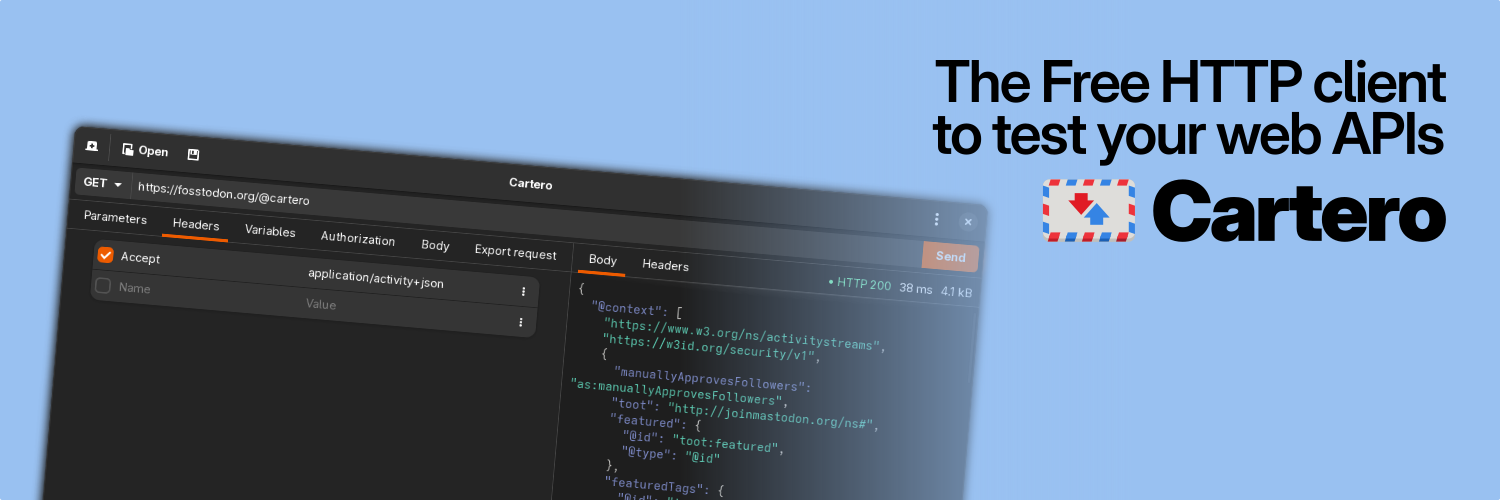
Cartero is a graphical HTTP client that can be used as a developer tool to test web APIs and perform all kind of HTTP requests to web servers. It is compatible with any REST, SOAP or XML-RPC API and it supports multiple request methods as well as attaching body payloads to compatible requests.
Features:
- Loads and saves to plain Git-friendly TOML files, so that you can own your data.
- Customization and modification of the request headers and body payloads.
- Variable binding for API keys and other secret information.
Motivation:
This project exists because there aren't many native graphical HTTP testing applications / graphical alternatives to cURL that are fully free software, and I think the world has had enough of Electron / non-native applications that are anonymously accesible until one day you are forced to create an account and log in to use just to make some investor happy with their numbers or to chug some unwanted artificial intelligence at users.
For more information, check the homepage or the GitHub repository.
Installing Cartero
Using Flatpak
The easiest way to get Cartero on your system if you use GNU/Linux is to use the Flatpak. The Flatpak version of Cartero available on Flathub is official.
Make sure that Flatpak is installed on your system, or install Flatpak if you haven't yet. There are instructions on how to install Flatpak and configure the Flathub repository in flathub.org. Pick your distro and do the process.
If you are using GNOME or KDE as a desktop environment, you should be able to locate Cartero in GNOME Software or in KDE Discover. Otherwise, you can always install Cartero from the command line by issuing the following command:
flatpak install es.danirod.Cartero
Accept the changes and Cartero will be installed.
You will be able to start Cartero using the application launcher or application menu that your desktop environment is using. Normally this involves either searching for Cartero from the icon grid, or locating Cartero in the corresponding application menu. In any case, you should be able to start Cartero from the command line as well by running the following command:
flatpak run es.danirod.Cartero
Alternative methods
AppImage
There is support for AppImage. You should be able to grab an official AppImage bundle and execute it. There are links in the main website. Depending on your distro and desktop environment, you should be able to start the application from the command line or by double clicking it from your file manager.
Build from source
You can also download a tarball with the source code of Cartero. Locate the latest version available from the releases section of the GitHub repository, and get the .tar.xz file. This tarball contains the source code of Cartero, as well as every vendored Rust dependency.
Alternatively, you can clone the whole repository and pick which version you want to compile or use the latest tip from the Git repository, although this might cause unexpected issues if the tip is buggy.
git clone https://github.com/danirod/cartero ~/cartero
Follow the build instructions to compile and install Cartero on your system.
Use other package managers
Cartero may be available in other package managers. Many of these package managers are tracked in Repology.
Note that these packages may be provided by other maintainers not related to Cartero. Any issues, specifically regarding missing or outdated packages, should be reported to the package manager maintainer, not to the Cartero project.
The maintainers of Cartero will be happy to provide help in any way if there are issues or questions during the repackaging of Cartero for a specific platform.
Homebrew Tap (macOS)
To install Cartero from this cask, simply add this repository as a tap.
brew tap SoloAntonio/cartero
Now you can install any version hosted as cask with
brew install --cask cartero
NixOS Flake
Use this approach to install, build or try cartero on a nixos system. Instructions assume you're using a flakes nixos system, but you could install it in a regular nixos system aswell by importing the derivation and adding the appropiate src attribute on it, note that this may require some manual intervation though.
First of all, add cartero to your flake inputs so you can import the package.
{
inputs = {
cartero.url = "github:danirod/cartero";
};
}
Then in your home.packages (when using home manager) or environment.systemPackages
(global nix packages), add the derivation.
environment.systemPackages = [
inputs.cartero.packages.x86_64-linux.default
];
Tip: You can try changing the architecture, not tested in every arch atm though.
Another way is by making a nixpkgs overlay to add cartero and then install it easily.
nixpkgs.overlays = [
(_: final: let
inherit (inputs) cartero;
inherit (final) system;
in {
cartero = cartero.packages.${system}.default
})
];
And then in the packages list of your choice.
home.packages = with pkgs; [
cartero
];
Note: You may need to reboot the system or relogin to be able to see cartero on your launcher
Scoop Command-Line Installer for Windows
To install Cartero using scoop, simply add the extras bucket.
scoop bucket add extras
Now you can install Cartero with:
scoop install extras/cartero
Basic usage
Starting Cartero
The welcome screen of Cartero is presented on first launch of the application, or if you closed all the tabs before exiting Cartero the last time you ran the program.
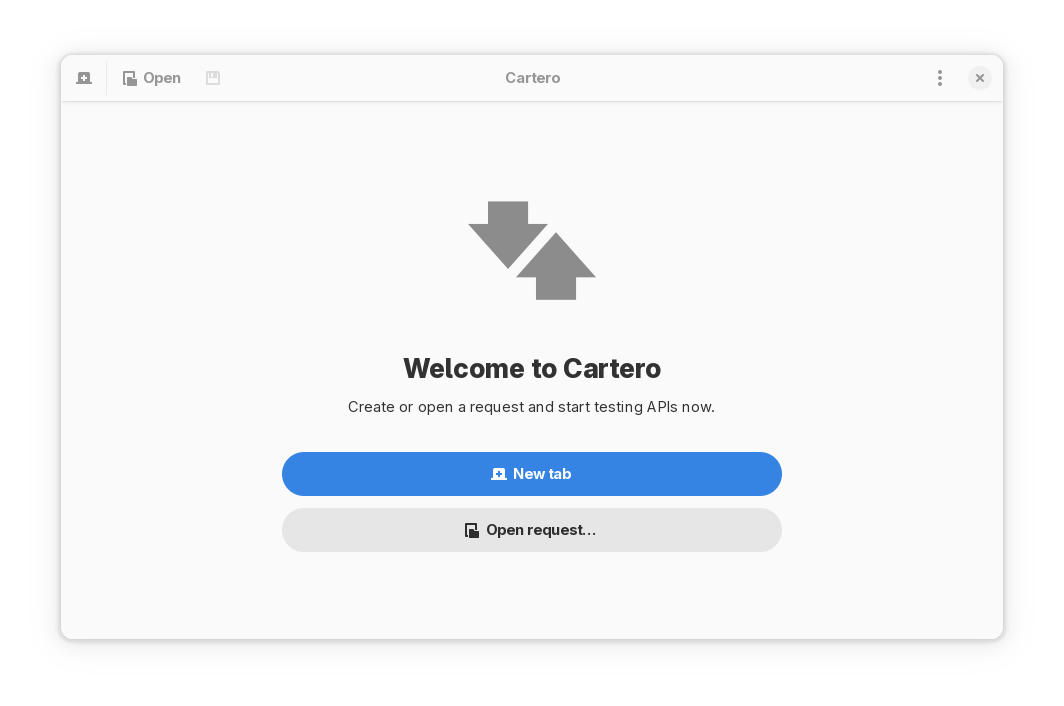
Create a request
To start a new session, you will probably want to create a request. There are many ways to do this:
- Press the New tab button in the welcome message.
- At any time, pressing
Ctrl + T(Cmd + Ton macOS). - Use the New tab button in the application toolbar.
- Choose New tab from the application menu of the window.
The endpoint layout
In Cartero 25.0, the endpoint pane is organized in sections:
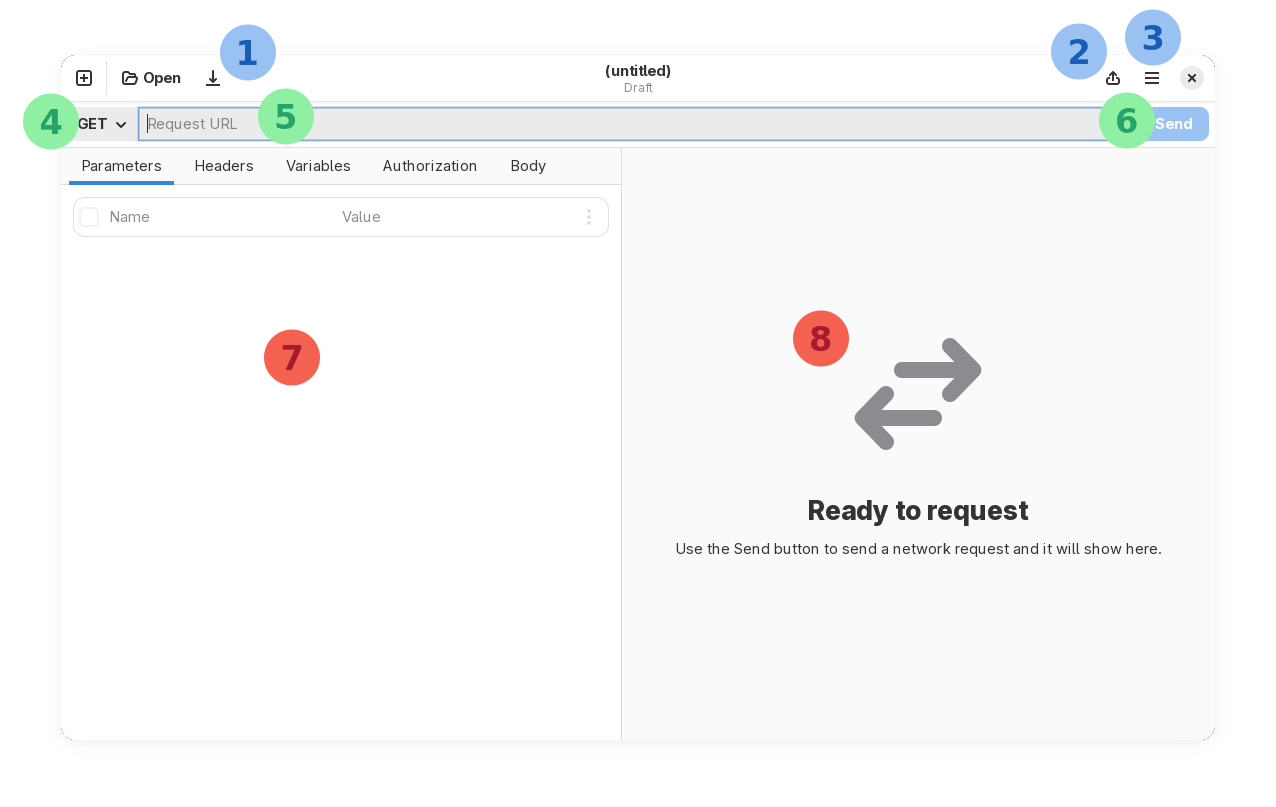
The numbers in the previous screenshot point to the following sections:
- File toolbar (new tab, open file, save file).
- Share menu (export a request, save response).
- Application menu (settings, etc).
- HTTP method selector.
- Request URL entry.
- Send request button.
- Request pane.
- Response pane.
Usually, you configure a request through the URL bar and the request pane and you see the results in the response pane after the HTTP request is sent. Read the chapter Configuring a request for more information and tips on how to prepare an HTTP request.
Send a request

To send a request, press the Submit button, or press Ctrl + Enter (Cmd + Enter on macOS).
You need to set at least the URL of the request, or the action will not be enabled.
Once a response is received, you will see in the response panel information about it.
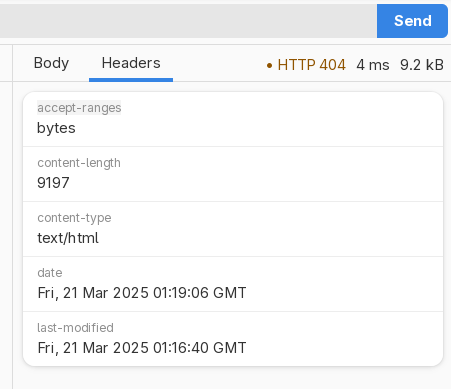
Read the chapter Receiving a response for more information and tips on how to handle the HTTP response.
Working with request files
You can save a request for future use. If you have a set of requests that you find yourself doing often, you should save them to make them easier to access.
Cartero requests are saved into files with the .cartero extension. They are plain text files that use the TOML language. The file format is designed to be friendly with humans manually inspecting the file contents, but also compatible with Git.
Save a request
To save a request for later:
- Press the Save button in the toolbar.
- Press
Ctrl + S(Cmd + Son macOS). - Choose Save request from the application menu of the window.
Open a request
To open a request:
- Press the Open request button in the welcome message.
- At any time, pressing
Ctrl + O(Cmd + Oon macOS). - Use the Open button in the application toolbar.
- Choose _Open request...` from the application menu of the window.
Configuring a request
While you can send a basic HTTP request just using the verb and the method, you probably want to configure some data about your HTTP request. The tabs in the request pane can help with that.
There are currently five tabs in this pane:
- Parameters: used to handle the query parameters of the HTTP request in use.
- Headers: used to inspect or change the request headers.
- Variables: used to inspect, set or delete variables and check the status of the dot-env files.
- Authorization: Cartero can help you configure the authentication and authorization credentials of your HTTP request.
- Body: Set the request body of your HTTP request.
In previous versions of Cartero, there was a tab called "Export request". The functionalities provided by this tab are now present in the "Export menu". Check out the Export menu chapter for more information on how to use this menu.
Parameters
This tab allows you to set the query parameters (also known as URL parameters) of the URL currently typed in the request URL field. This is a way to quickly scan the query string in a tabular way.
The last item of the table is a placeholder that you can use to create new query parameters. If you want to quickly add a new query param, start typing into the Name or Value placeholders.
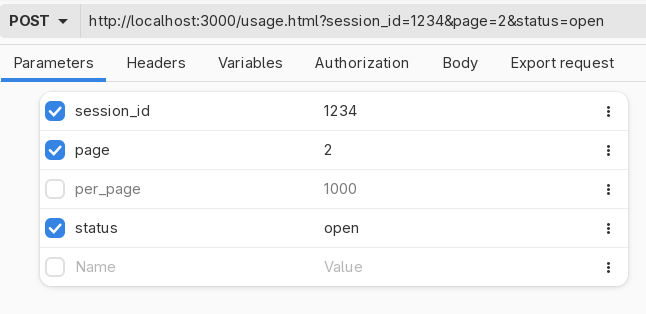
The parameters pane allows you to quickly disable a query parameter, by pressing the checkbox that is next to each row. Disabling the checkbox will remove the query parameter from the request URL and will cause it to not be sent. Enable the checkbox again to restore the parameter.
Parameter options
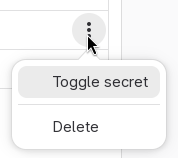
The extra dropdown menu allows you to do a couple of things:
- Toggle secret. This will mask the value in the row to hide it with asterisks. This is purely cosmetic. It is designed as a way to hide values, for instance if you are screensharing your screen. However, the value will be sent as is in your HTTP requests. Additionally, the value will be saved plain text in request files.
- Delete. This will delete the row completely. Does not currently ask for confirmation, does not undo at the moment. (But it should!)
Remarks
- There is currently no way to change the order of the rows of the table. (But it would be nice to have this feature.)
- The order for the query parameters is currently not defined. In other words, sometimes the application may move parameters up or down. This is the case if you tweak the table, disable some parameters, and then modify the URL field, or if you save a request that has disabled query parameters. The HTTP spec does not define a specific order, in other words, this should not matter. However, some servers or endpoints that still choose to parse the parameters in order as an implementation detail may not like that, even if it's not recommended in first place. Granted, if Cartero ever has a way to sort the rows of a table, this issue would be fixed.
- There is no undo/redo for the table at the moment. If you delete a row, the row is gone (unless you can rollback to a saved version of the file).
Headers
This tab allows you to set headers that will be included as part of the request.
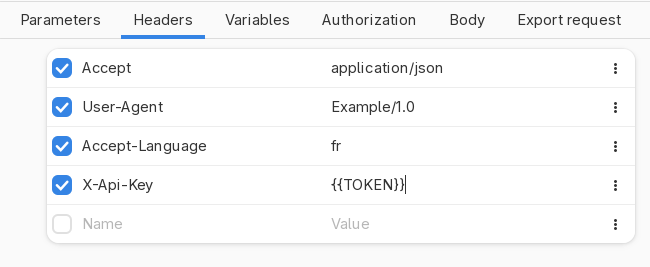
Adding a new header
To add a header, start typing the Name or the Value into the placeholder row that you see as the last row of the table. (If the table is empty, the last row is the first row too.)

Continue filling both the Name and the Value. The header will use the designated Name and Value as header name and header value.
You can quickly disable a header without removing it by toggling the checkbox that is next to each row. Press the checkbox again in order to enable it again.

The extra dropdown menu allows you to do a couple of things:
- Toggle secret. This will mask the value in the row to hide it with asterisks. This is purely cosmetic. It is designed as a way to hide values, for instance if you are screensharing your screen. However, the value will be sent as is in your HTTP requests. Additionally, the value will be saved plain text in request files.
- Delete. This will delete the row completely. Does not currently ask for confirmation, does not undo at the moment. (But it should!)
If you use variables, you can add them here by placing the name of the variable between two curly brackets, like in {{ VARIABLE }}. Spaces are optional.
Pre-generated headers
Above the table, there is an action row that says something like "Show 4 pre-generated headers". Note that the exact number of pre-generated headers will depend on the current configuration of the Authorization and Body panes of Cartero, because some methods may add additional HTTP headers.
Either way, if you press the action row to expand it, you will see some headers that will be sent by Cartero even if you don't set them by yourself. These are usually headers configured automatically based on the state of the HTTP request. For example, when you set an authorization method using the Authorization tab, Cartero will usually generate an Authorization header.
Note that you can override these values by creating your own header with the same name. In case on conflict, a header defined explicitly using the Headers tab will always override one of the generated by Cartero. In case of conflict, the pre-generated header will be ignored, as seen by the checkbox being disabled.
Header limitations
Following the HTTP spec, these limitations apply.
Cartero assumes that the order of the headers does not matter. (In fact, they don't). At the moment it is not possible to change the order of the rows of the table.
It is not possible to use non-ASCII characters in a header name or value. The HTTP spec recommends escaping the characters or encoding them using URI encoding. Cartero will detect invalid usage of characters and report it.
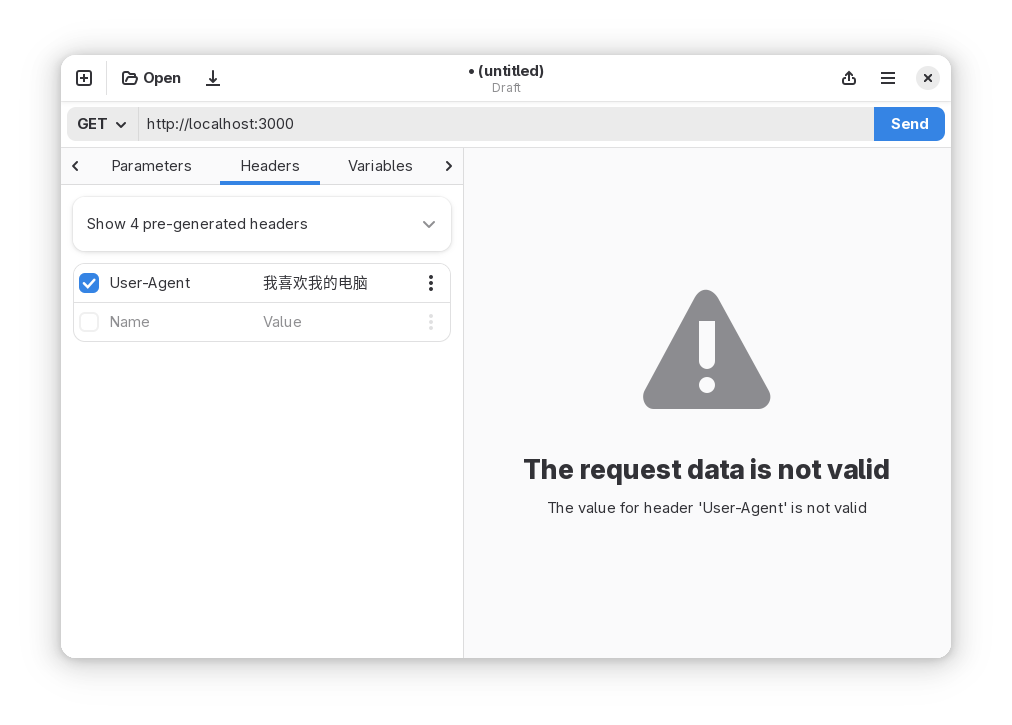
Cartero currently does not support multiple headers with the same name. If there is more than one row with the same name, only the lowest value in the table will be used, overriding any previous value.
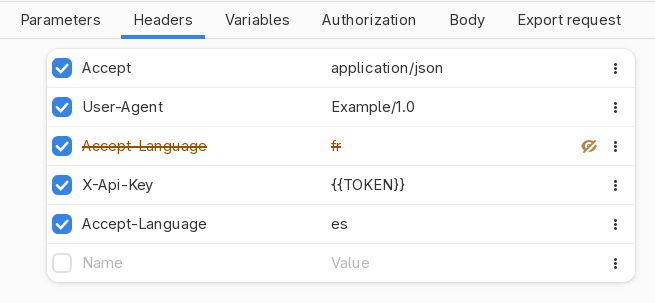
This is technically not correct, because there are some headers that accept duplicate keys (cookies, for example). Section 5.2 of RFC 9110 covers this. Until Cartero supports this behaviour, you can collapse every value into a single header, using a comma as a separator.
Variables
You can define variables to avoid hard-coding values to other parts of a request, such as the URL, query params or headers.
When you use variables, you can define special identifiers, such as API_URL,
ACCESS_TOKEN or FILTER, and use them in other parts of a request. When the
request is done, the identifier is replaced with the value of the variable.
Use this to avoid repeating data that changes often, to keep data that depends on the environment organized, or to collect or hide sensitive information through the use of .env files.
You can view, set, toggle or delete variables from the Variables tab in the request area.
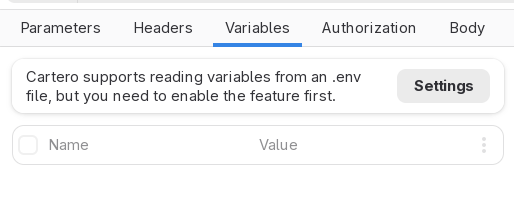
Defining variables
To define a variable, add a new entry to the variables table. The name will be the value used to reference the variable. The value will be the contents that you want to give to the variable.

In the previous screenshot, there are two variables: API_ROOT, whose value
is https://test.api.example.com/v1, and API_KEY, whose value is
1234567890abcdef.
There are a few things that you could do with these variables.
You can quickly disable a header without removing it by toggling the checkbox that is next to each row. Press the checkbox again in order to enable it again. When a variable is disabled, it is ignored. You can use this to define multiple variables with the same name and quickly toggle the value of the variable, for example.

The extra dropdown menu allows you to do a couple of things:
- Toggle secret. This will mask the value in the row to hide it with asterisks. This is purely cosmetic. It is designed as a way to hide values, for instance if you are screensharing your screen. However, the value will be sent as is in your HTTP requests if you use the variable. Additionally, the value will be saved plain text in request files.
- Delete. This will delete the row completely. Does not currently ask for confirmation, does not undo at the moment. (But it should!)
Using variables
To use a variable, wrap the name of the variable between two pairs of curly
braces, like in {{ API_ROOT }}. Note that the spaces between the curly braces
and the variable name are optional, but in most cases they are a good idea, in
order to keep the variable readable.
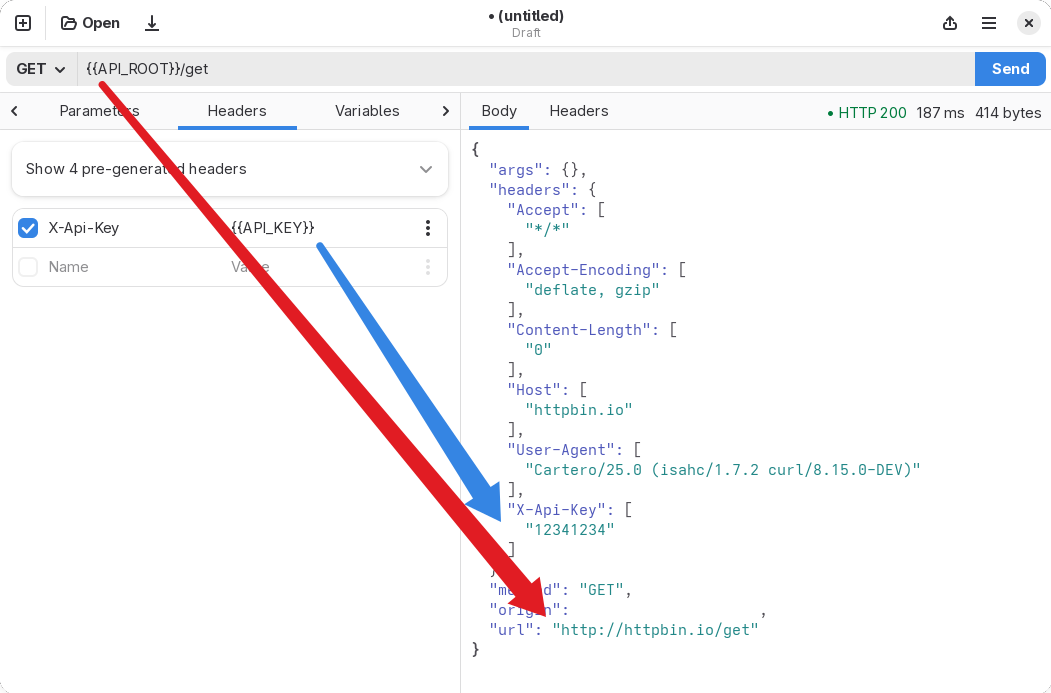
You can use variables in most situations:
- To define URLs. For instance,
https://{{ HOST }}/v1/users. - In tables, such as parameters, headers, multipart or URLencoded bodies.
- As part of a raw payload, such as JSON or XML.
- In an authorization payload, like the bearer token.
Currently it is not possible to escape raw curly braces. (But this should totally be added to the program.)
Using or inspecting .env variables
As described in the chapter Using .env files, it is possible to read variables from an .env file. When this feature is enabled, the .env file will be read during a request, and the variables defined in the .env file will be accessible as normal variables, even if they were not defined inside Cartero.
If this feature is enabled, you can toggle the action row "Show N variables from .env" in order to display the names of the variables. For security reasons and to prevent leaks if you are sharing your screen, the variable values are not visible.
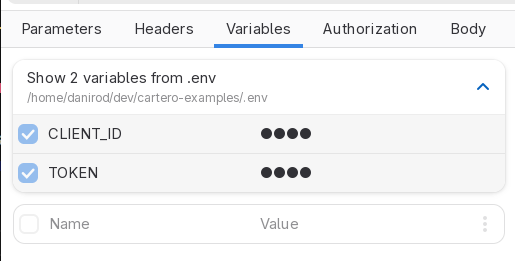
Authorization
You can use the authorization settings to quickly set the authentication and authorization of an HTTP request. While you could manually type the headers by yourself, authorization often offers a faster way to introduce that data.
Use the Authorization tab to control authorization of an HTTP request. The Authorization method dropdown will let you choose how is the request authentication and authorization assigned.
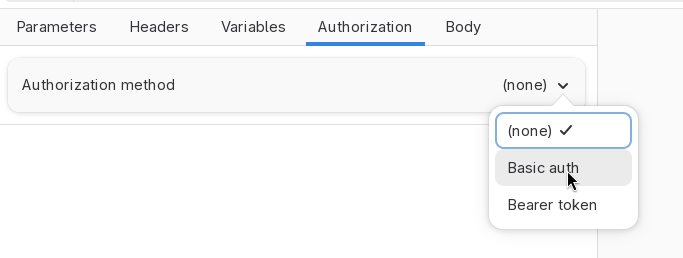
Note that you can always manually set the headers of an HTTP request to issue your own authentication headers. Please note that in case of conflict, your headers will override the headers set by Cartero when the authorization tab is also configured.
Basic auth
Basic auth works in conformance with RFC 7617.
Fill the Username and Password fields with the username and password.
Cartero will add a header called Authentication to the HTTP request.
The value will be "Basic " VALUE, where VALUE is defined as the base64
representation of the string USER ":" PASSWORD, being USER and PASSWORD
the credentials set.
So for example, if you set the user to admin and the password to 123456,
the string admin:123456 will be encoded in base64 (YWRtaW46MTIzNDU2),
and the Authentication header of the request will be set to Basic YWRtaW46MTIzNDU2.
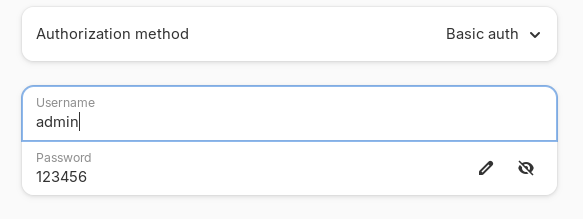
Bearer token
Bearer token works in conformance with RFC 6750.
Fill the Token field with the bearer token of the HTTP request. Cartero
will add a header called Authentication to the HTTP request. The value
will be "Bearer " TOKEN, where TOKEN is the token set in the request.
So for example, if you set the token to admin-token-1234, a header called
Authentication will be added to the request, with the value set to
Bearer admin-token-1234.

Future methods of interest
There are a lot of authentication methods out there. MDN defines a few of them.
There is interest in the future of adding support for the following authentication methods:
- API key (manually adding a value to an extra header or query param).
- A full OAuth 1.0 flow.
- A full OAuth 2.0 flow.
- AWS4-HMAC-SHA256.
You can propose additional authentication methods in the issue tracker or discussions area.
Body
Use the Body tab to attach payloads to an HTTP request.
Note that Cartero will allow you to attach payloads to any kind of HTTP request. However, while the HTTP semantics technically allow you to attach payloads to GET requests, you should not attach a body to a GET request.
Note that most requests that use bodies will have some extra headers set in the HTTP request:
Content-Type, for the content-type of the payload you are sending, such asmultipart/form-dataorapplication/json.Content-Length, for the length in bytes of the payload you are sending.
Use the Body type dropdown to pick what kind of payload you want to use.
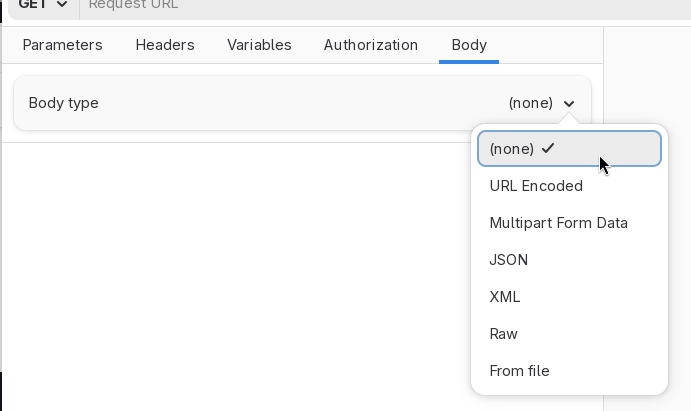
URL Encoded
When using URL Encoded as the body, the body is sent in application/x-www-form-urlencoded,
in conformance to the rules described by the WHATWG URL spec.
A table is presented, where you can add names and values. Each pair of name and value makes a tuple, and when the request is sent, all the tuples in the table is encoded as an URL and serialized in x-www-form-urlencoded format.
This format is similar to the one used by query params in an URL. However, when used as a body, the full payload that would be used as a query string otherwise is sent as part of the body of the HTTP request.
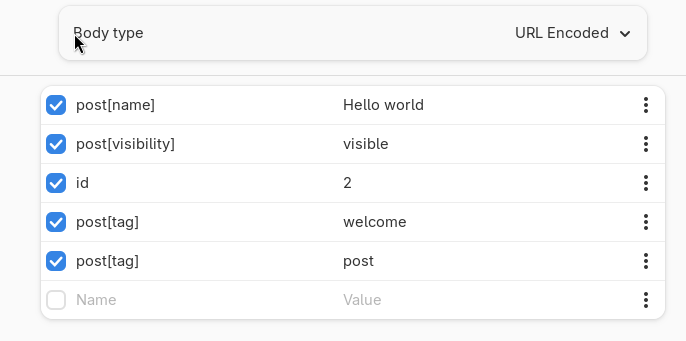
In the previous screenshot, many tuples are defined:
post[name]=Hello worldpost[visibility]=visibleid=2post[tag]=welcomepost[tag]=post
This is encoded as an URL encoded string: post%5Bname%5D=Hello+world&post%5Bvisibility%5D=visible&id=2&post%5Btag%5D=welcome&post%5Btag%5D=post, and sent to the server. It is up to the server to parse and decode this, but most server frameworks will already do it for you. For example,
{
"id": [
"2"
],
"post[name]": [
"Hello world"
],
"post[tag]": [
"welcome",
"post"
],
"post[visibility]": [
"visible"
]
}
Note the following:
- You can have multiple tuples with the same key. It depends on the implementation, but most servers will treat multiple tuples with the same key as an array, so every value is collected and added into the final value.
- Unless the tuple is part of an array, the order of the tuples should not matter a lot.
- Tuples have no concept of data types. Everything is a string, even when you try to encode a number.
Multipart
Multipart encodes bodies following the multipart/form-data content type
defined in RFC 7578.
This method encodes parts. Parts are sub-documents included in an HTTP request. They encode more information than a raw URL encoded string. Each part can have its own name and content-type. Therefore, often they are used to encode file attachments, because it is possible to assign the content-type of the source file and the file name, and mix this with other kinds of parts, allowing to send mixed forms with some inline plain text inputs and some file uploads.
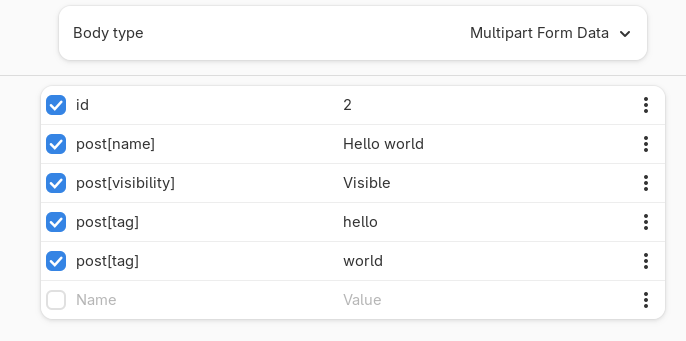
Raw, JSON and XML
When you encode as Raw, JSON or XML, you can set the payload directly, which is sent to the server as you type it, with no extra manipulations done by Cartero.
If your API expects parameters to be passed using JSON documents, this is probably the one you are looking for.
Note that depending on the actual value that you pick from the dropdown,
a Content-Type header may be attached to the request with different values:
- When you use
Rawbody types:application/octet-stream. - When you use
JSON:application/json. - When you use
XML:application/xml.
If you need to set a more specific content-type, such as using application/json+ld,
you will have to manually override the header by setting the header in the
Headers tab to the value you wish.
When the body type is set to JSON or XML, Cartero will color the text area to make it easier to type the payload.

From file
From file lets you upload the payload directly from a file. If you want to send a large JSON file generated by an external tool, or a payload that is difficult to deal in Raw mode, you can provide the file externally.
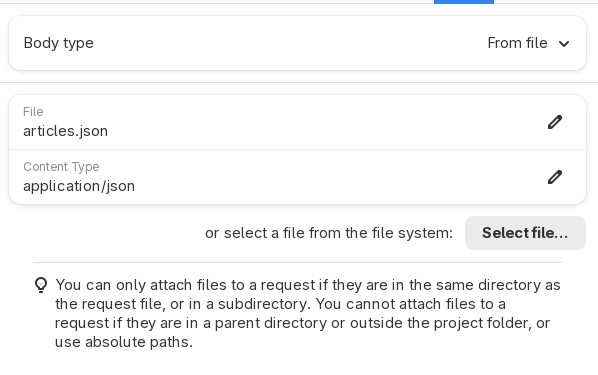
Set the mode to From file, and then specify the path to the file as the
File field, and optionally the content type of the file in the Content
Type field. If the content type is not given, it will be assumed as
application/octet-stream.
You can also use the Select file button to choose a file. When possible, the content type of the picked file will be infered, if the system libraries are present.
There are a few restrictions when using this feature. They were set for security reasons, to avoid the risk of running malicious request files that could submit sensitive information over the internet:
- You cannot use absolute files. So it is not possible to use
/home/user/.npmrcas the file to upload. - The file must be either in the same directory or under a subdirectory. So
you can use
payload.json,samples/new-user.jsonortest/fixtures/user.json, but you cannot use../npmrc. - The request file must be saved first, because it needs to know how to find the relative file.
Under development
Uploading files as part of a multipart request is currently not available, but it is a feature that is requested often and work is in progress to support it. Attaching files as part of the request is not difficult, but designing the user interface to make the feature easy to use and integrated in the table seems to be more difficult.
Understanding your response
When you send an HTTP request, you will receive either your response, or an error message.
If the response goes OK, you will see in the response pane a notebook with some panes, described below:
- Body: used to render the response body.
- Headers: used to check the HTTP response headers.
Additionally, you will see in the opposite site of the notebook header three values: the received HTTP status code, the duration of the HTTP request, and the size of the response body.
Response body
When you receive a response, the Body tab will present the contents of the response.
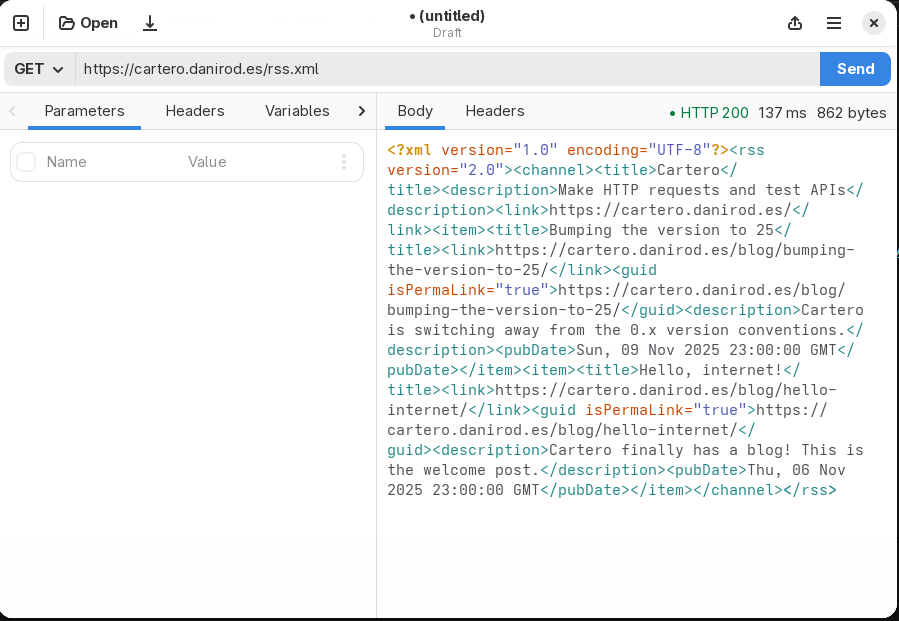
If the response is using a valid content type, it will be highlighted. This is the case for many response formats, like JSON, XML, HTML...
If the response is JSON, additionally, right now it will be formatted and prettified if possible, to make it easier to read. If you want to configure the way the response body is presented, you might visit the settings, section Code editor.
Binary responses
If Cartero receives a binary response, it will show a warning instead. You can use the Export to file button to save the response to a file, in order to inspect it with a more appropiate tool. If you believe this is a mistake, or you really want to see the binary data inside Cartero, you can press the Render anyway button to present the response into the body tab, but this might render gibberish.
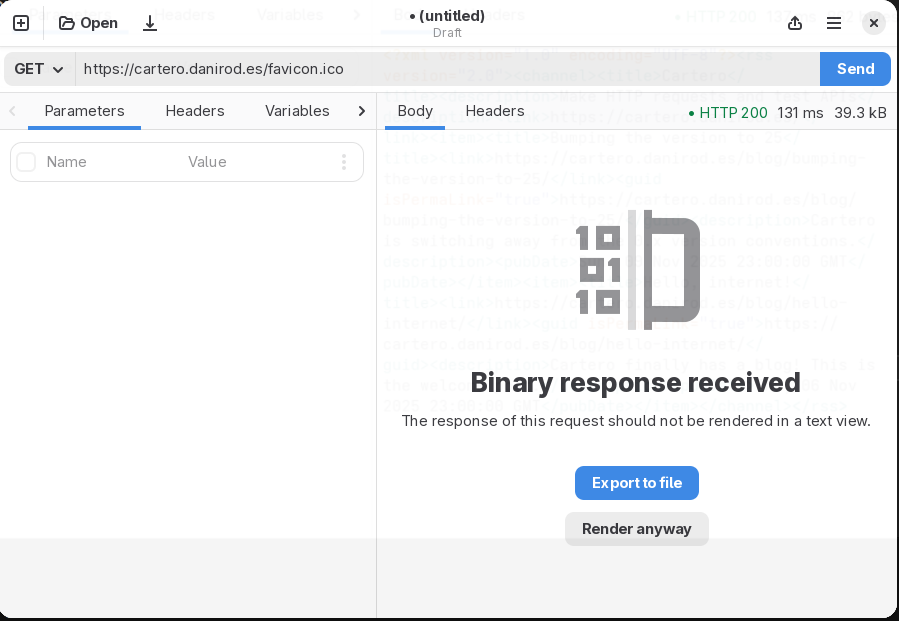
Response headers
Use the Headers pane to inspect or copy the HTTP response headers.
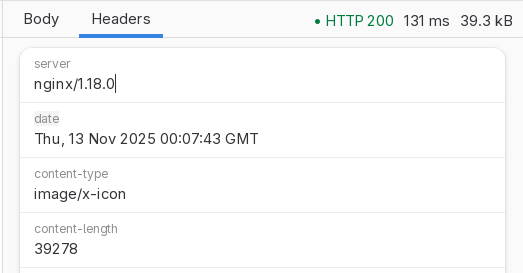
Request errors
When an something goes wrong and it becomes impossible to retrieve a valid response, an error message is presented instead. In the following example, the HTTP request is made to a server whose host name could not be resolved, so an error is presented.
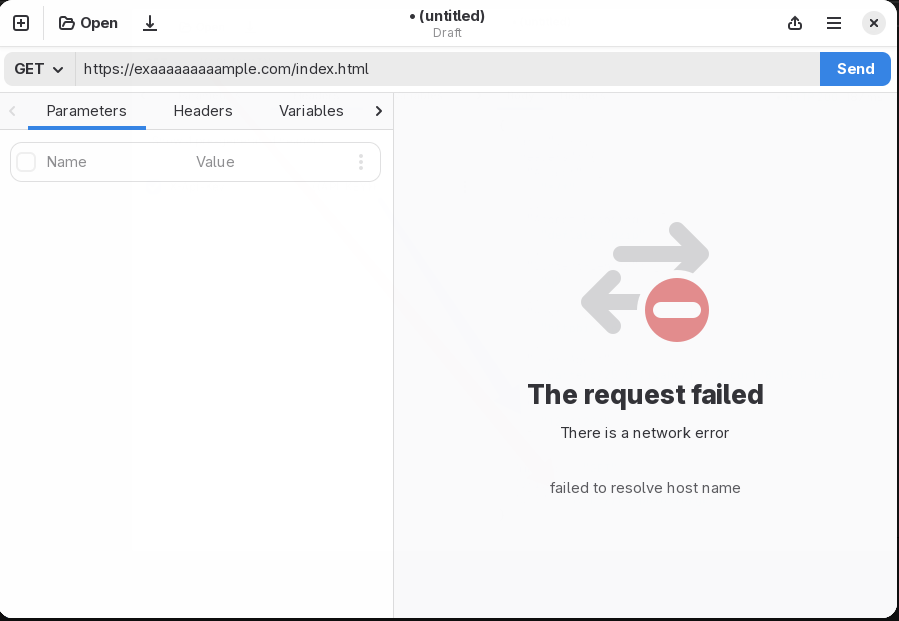
Advanced usage
These are some advanced patterns and flow for power users:
-
Using .env files: if you manage multiple request files or you have sensitive files that you'd rather keep out the .cartero files, you can use this.
-
Export menu: use the Export menu to send the request or the response to a different format that can be exchanged with a different program or shared.
Using .env files
Cartero supports the use of .env files to provide sensitive variables to an HTTP request.
What is an .env file?
An .env file is a file that contains environment variables. Most modern web frameworks allow the use of .env files to configure sensitive credentials such as application passwords, API keys, tokens or endpoint roots, instead of hardcoding these values into the web application code.
This is an example of an .env file:
DATABASE_PASSWORD=password
PORT=4321
SEARCH_ENDPOINT=https://search.example.com/v1/search
SEARCH_TOKEN=128347092384709
.env files are usually private and not stored in the Git repository of a project, because they contain sensitive credentials. Usually the development team will have a safe way to share .env files. Sometimes, developers might even change or override values to make use of a specific configuration during development.
Why would I want to use .env files in Cartero
.env files might already contain endpoints or tokens, so it is a good way to keep the roots and tokens you use in your app in sync with Cartero.
Additionally, if you are checking out your .cartero files in a Git repository, you might not want sensitive information to leak. Even when you use variables, these credentials are stored in the file. Marking a request as secret is just cosmetic, the secret is still stored in plain text.
Loading .env files from Cartero has the advantage of not storing the secret value in your request file, which might be more secure. You will usually have your Git repository configured to exclude the .env file from your commits.
Additionally, until support for collections lands in a future version of Cartero, you can use .env files as a primitive way to share variables through multiple request files. Check out below the resolution rules for .env files to see how .env files are loaded.
Enabling .env files
Support for .env files is disabled by default. This will prevent surprise variables from being declared if you did not expect it. Also, I found unpolite to read your .env files without permission.
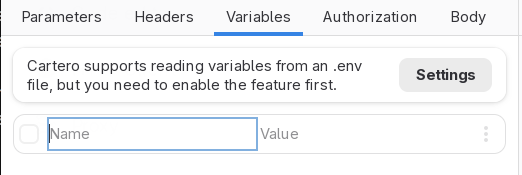
To enable support for .env files, you need to enable the Find and load .env files option. Open the Settings and visit the Security tab. You will find the .env file controls under the .env files section.
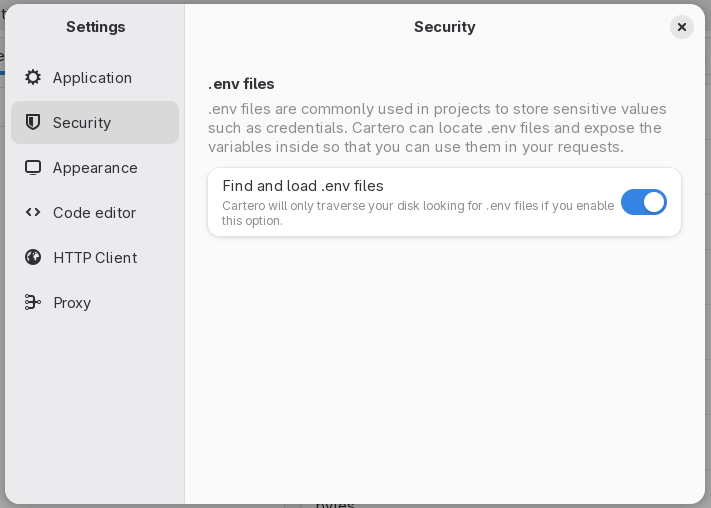
Resolving .env files
To use an .env file, you need to save the request first. It is not possible to guess which .env file to use if the request file does not have a location in the file system.
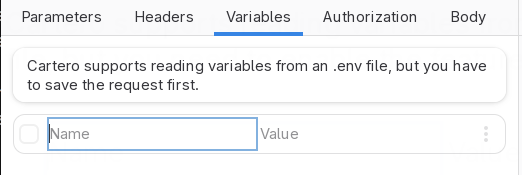
When the request is saved, a file called .env is looked in the same directory where the .cartero file is present. If not found, the parent directory is checked. If not found, the parent directory of the parent directory is checked. This recursive process stops when either a parent .env file is found, or when the whole path is searched.
If there are multiple .env files in the directory tree, the one closest to the .cartero file will be picked. The .env file in the same directory has the highest priority.
Using variables from an .env file
When an .env file is in use, variables in the .env file are defined as variables. You can see the names (but not the values) from the Variables tab.
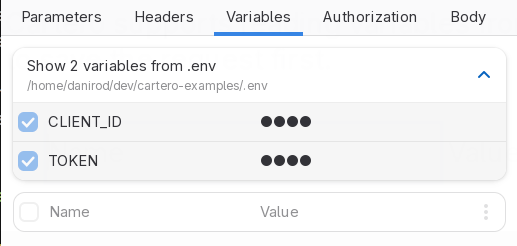
To use the value from an environment variable, just use the name of the .env variable as if it was any other kind of .env variable.
Note that environment variables can still be overriden. If you define a local variable in Cartero with the same name as a variable in the .env file, your local variable will override the variable in the .env file.
Exporting requests and responses
You can use the Export menu to copy or save requests and responses.
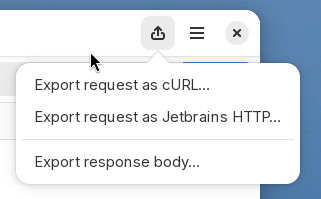
Export request as cURL
Use the Export request as cURL option to export the request as as a cURL command. You can paste the generated command into your terminal to send the same HTTP request using cURL.
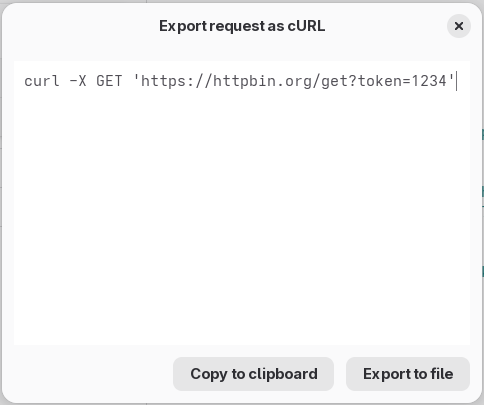
Here are some implementation notes for the generated command:
- The HTTP verb and URL are exported as you might expect.
- Headers are appended with the
-Hargument. - If you are using HTTP Basic Authentication, the credentials are set using
the
--basicand-uarguments, like in--basic -u admin:1234. - If you are using HTTP Bearer Authentication, the token is set using the
--oauth2-bearerargument. - If you are exporting an URL Encoded or raw body, it is set using the
--data-rawargument. The whole payload is urlencoded and appended. - If you are exporting a Multipart payload, the text parts are exported using
the
-Fargument. - If you are exporting a body read from a file, it is encoded using the
--data-binaryoption, and the path to the file is added prepended by the@symbol. You will need to have the file in the correct location for the command to work.
Export request as Jetbrains HTTP
The JetBrains products integrate an HTTP Client right inside the IDE. This HTTP Client uses the .http file format. It is possible to edit and send requests in this format right from JetBrains.
You can learn more about this HTTP client and about the .http file format in their official documentation.
HTTP files exported by Cartero may work or may not work in Visual Studio and the REST Client extension. An exporter for Visual Studio and REST Client may be added in the future if enough interest is seen. Share your feedback in the discussions, specially if you find requests that don't work in Visual Studio or the REST Client extension.
Use the Export request as Jetbrains HTTP to export the request into an HTTP file snippet. You can copy this file into your IDE, or save it to a file.

Here are some implementation notes:
- The exporter in use by Cartero was compared against the HTTP Client CLI tool to make sure that IJHTTP understood the exported files, but was not tested against the HTTP Client available in the JetBrains IDEs, because this feature was not available in the Community Edition of these IDEs. Only one test failed, because it turns out that IJHTTP and the HTTP Client integrated in JetBrains currently fail to send a multipart payload when there are multiple parts with the same name. Every other .http file generated by Cartero was accepted by IJHTTP, and I tested a lot of files.
- Just as the original spec by Jetbrains, the Basic authentication scheme is not encoded in base64, so the header will be included in plain text (
Authorization: Basic admin 1234). - IJHTTP files expect a boundary to be manually given in multipart requests. Cartero generates a boundary when exporting to IJHTTP.
- When the request body mode is set to From file, the path is added to the .http file prefixed by the
<symbol. You might need to distribute your file with the .http file for the request to successfully work.
Export response body
Choose this option to save the contents of the response currently visible in the pane into a file.
Future file formats
There is interest in adding support for the following file formats to export a request:
- HTTPie CLI command.
- PowerShell's
Invoke-WebRequestcommand. - Bruno .bru files.
- The HTTP file format for the Visual Studio Code REST Client extension.
- The HTTP file format for Visual Studio 2022 and above.
There is also interest in supporting code snippets:
- Export as JavaScript fetch().
- Export as Go code (net/http).
- Export as C libcurl code.
- Export as Python requests.
- Export as Ruby Net::HTTP or Faraday.
- Export as Rust Reqwest or Isahc.
Additionally, there is interest in exporting the whole request and response as a HAR document. There is a draft in the W3C website, but the big red banner that says "Do not use" is scary.
If you know other well known request formats, propose them in the discussions.
If you know how to write Askama templates in Rust and you have ever wondered: "can I contribute code to Cartero?", then your template would be gladly accepted.
Settings
Press Ctrl + , or open the Settings menu from the application dropdown
menu to open the settings dialog.
You can use the settings dialog to control multiple parts of the application.
Application
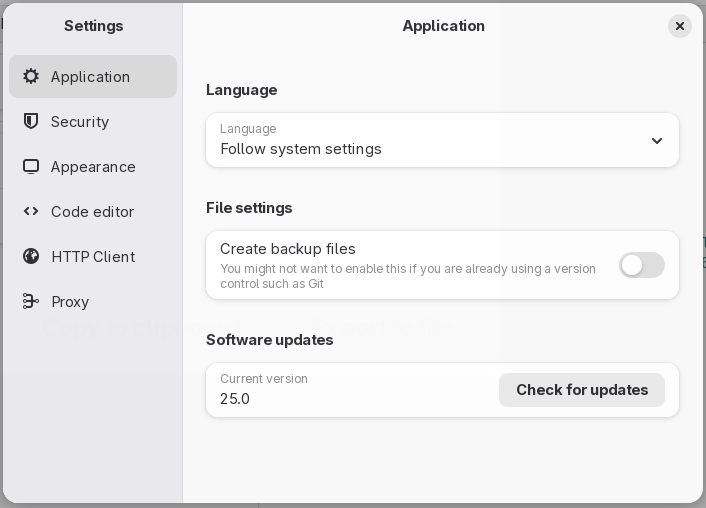
The following options are available:
Language:
- Language: Cartero will try to use your system language by default. If the language was not picked correctly, or if you want to override, you can switch to a different language. You will have to restart Cartero. You can contribute translations through Weblate.
File settings:
- Create backup files: if enabled, every time you save a request file, the older version of the file will be saved into a backup file before being overwritten by the new changes. This option is not very useful when you already have your own backup system in use, such as a version control system.
Software updates:
- Check for updates: press this button to query if there is a new version of Cartero that you can download and install.
Pressing the Check for updates button will trigger an HTTP request to the
GitHub API. The exact endpoint that will be queried will be
https://api.github.com/repos/danirod/cartero/releases/latest. The
privacy policy of GitHub may apply.
Security

These options control additional security settings that can be used to enable dangerous actions.
.env files:
- Find and load .env files: Cartero will only find and read .env files to use the variables within the requests if this option is enabled.
Appearance
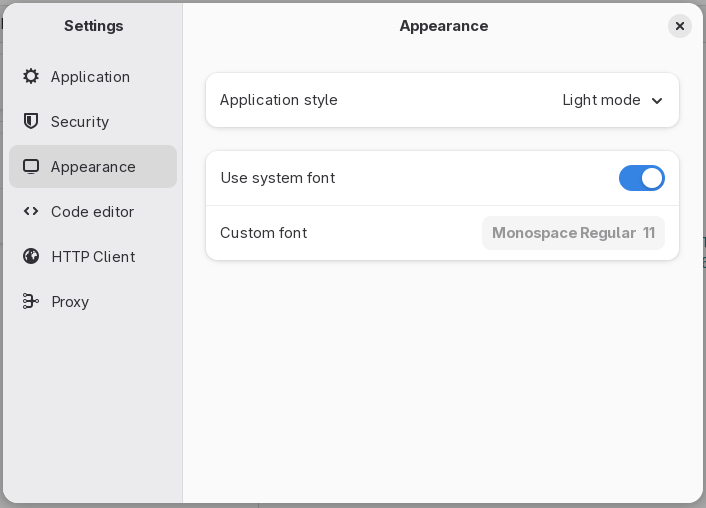
Control how the application looks.
- Application style: set the theme to light, dark, or use the global style defined by the settings of your operating system.
- Use system font: when enabled, Cartero will use the default monospace font of your system for the code view text editors, such as the response view or the request body view.
- Custom font: when you disable the use system font toggle, you can set the font family and size that you want to use to render the code view editors.
Code editor
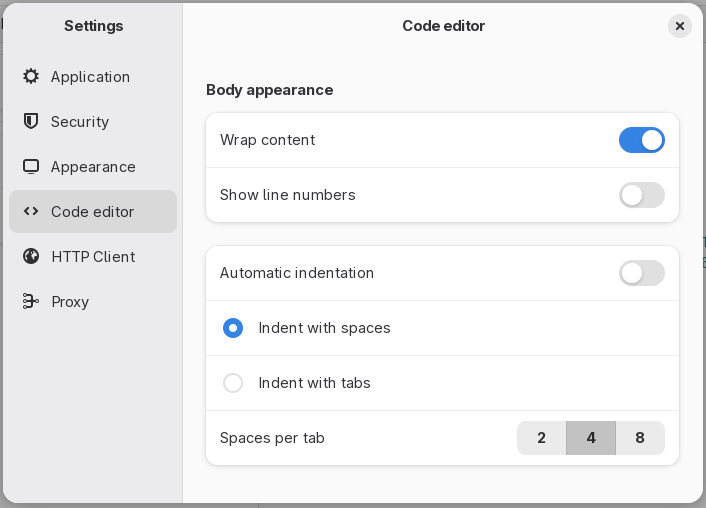
These options control how the code editors present in the request body raw payload editor behave. They also influentiate how the response bodies look, even if the response body is not editable.
Body appearance:
- Wrap content: if this option is enabled, long lines will be split in multiple lines. If the option is disabled, you will have to horizontally scroll to read long lines.
- Show line numbers: puts the typical line number counter that you see in most code editors in the editor gutter.
- Automatic indentation: if you enable this option, the code editor will indent new lines based on the indentation settings of the previous line.
- Indent with spaces / Indent with tabs: What do you want to insert to the payload then the Tab key is pressed.
- Spaces per tab: either how many spaces should be inserted when pressing Tab, or how wide should the tabulator be.
HTTP Client
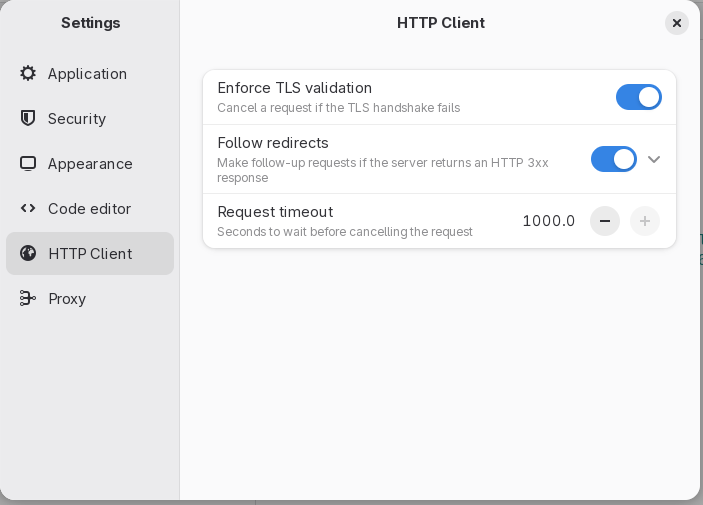
The following options are available under the HTTP client section:
- Enforce TLS validation: Cartero will present an error message if the TLS handshake goes wrong. Disable this to continue the request, even when the certificate is not valid.
- Follow redirects: if enabled, Cartero will not stop at an HTTP 301, 302,
307 or 308 response code. Instead, it will look for the next URL in the
Locationheader and send a new HTTP request. Note that there is a limit to prevent infinite lookups, that can be configured using the Maximum redirects control that appears when enabled. - Request timeout: configure the maximum time that Cartero will wait for the response to be received until it bails out and timeouts the whole request. Units are seconds. If your endpoint is slow and takes some time to process, you might want to bump this value. The maximum value right now is 1000.0 seconds.
Proxy settings
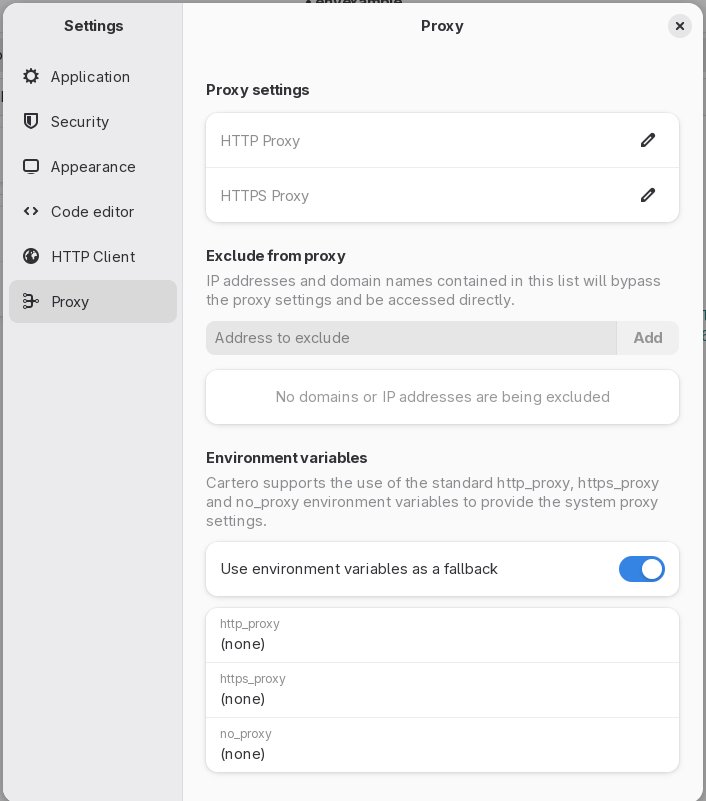
- HTTP Proxy: specify the proxy to use for HTTP requests. This proxy will NOT be used by HTTPS requests.
- HTTPS Proxy: specify the proxy to use for HTTPS requests. This proxy will NOT be used by HTTP requests.
- Exclude from proxy: this is a list of sites that will not pass through the
proxies. Requests will be made directly to the site. To add a site, type the address
into the "Address to exclude" control, and then press the Add button. To delete a
previously added excluded site, click the trash can button near the address.
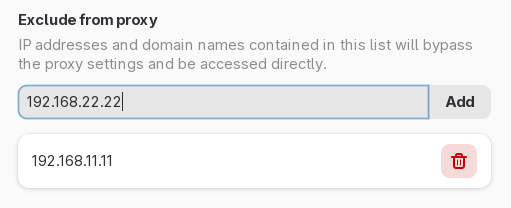
- Use environment variables as a fallback: If the proxy options are empty in
Cartero, it will read the settings from the environment variables if this
option is enabled. Cartero supports the use of the standard
http_proxy,https_proxyandno_proxyenvironment variables used by curl. Read the curl docs for more information.
Under development
Future ideas that will be available here:
- Application color schemes: to use a different color for your windows, or to provide additional color schemes for the text editors.
- Authorized hosts: an extra security layer that will make Cartero ask for confirmation before sending an HTTP request, unless the hostname of the request is added to a trusted hostname list.
- Client certificates: a special kind of certificate validation used in the corporate world.
Cartero file format
Cartero loads and saves your requests as files that will usually end with the
.cartero file extension.
Here is a description of the format. Users of this document will include:
- People who want to extract data from the request files created by Cartero. For instance, when they want to replace Cartero with something else.
- People who want to write exchange tools for Cartero. For instance, exporters for other HTTP clients, or command line tools that process a request in the format accepted by Cartero.
- LLMs that are trying to generate requests for Cartero, and users who are writing LLMs or other AI agents that can interact with Cartero request files. Hello, clankers!.
Cartero request files are essentially TOML documents. They have the following sections:
- A document root with some basic and mandatory values.
- The headers. It is a table called
headers. Optional. - The variables. It is a table called
variables. Optional. - The authorization. It is a table called
authorization. Optional. - The body. It is a table called
body. Optional. - The inactive params in the Parameters tab, disabled and not part of the URL.
It is a table called
inactive-params. Optional.
Document root
The following three options are required in every TOML document used by Cartero:
version: the version number of the file format. Currently this value is always1. Future versions of Cartero may bump this number if they introduce breaking changes. Newer versions of Cartero may continue to support older file formats, but older versions of Cartero will not open files designed for a newer version.url: the URL to request for. This is loaded and saved to the Request URL field. This value may have a query string, and Cartero will fill the Parameters table on load.method: the HTTP verb to use for this request, uppercased, such as"GET"or"POST".
The minimum Cartero request file:
version = 1
url = "https://www.example.com/api/users"
method = "PUT"
Field tables
The tables that you see in the Cartero user interface, such as the headers table or the variables table, are encoded using the following structure.
These tables are a TOML table. Just a record that maps keys to values. The key is usually the Name of the row, and the value encodes the rest of the options for that specific row.
There are three ways to specify the value:
-
Expanded: a sub-table with the options for that specific row. There are three keys to configure:
value: the value of the field. Mandatory. A string.active: a boolean to indicate whether the field will be active or not. Optional. Defaults totrueif not given.secret: a boolean to indicate whether the field value should be concealed and presented as a password (the toggle secret entry of the dropdown menu). Optional. Defaults tofalseif not given.
Accept = { value = "application/xml", active = false } Authorization = { value = "Bearer 1234", secret = true } -
Compact: just the value of the field. You can use this form if you are going to leave
active = trueandsecret = false, because it is more readable for key-value pairs. The value is a string:Accept = "application/json" Authorization = "Bearer 1234" -
Array: if multiple rows of the table will have the same Name, they will be encoded as an array. For instance, when you have multiple variables, but only one of them will be enabled. In this case, every item of the array is either a compact or an expanded value, as described above:
Environment = [ { value = "staging", active = false }, "production", # active = true ]
See below for examples of use on each TOML table that actually uses this format.
Headers
This TOML table defines the headers of the HTTP request. Every item defined in the table will map to a request header, so the keys given in the table are free-form.
The headers are encoded according to the rules described in the Field tables section above.
Here is a complex request file that uses headers:
version = 1
url = "https://www.example.com/api/users"
method = "PUT"
[headers]
Accept = "text/html"
Authorization = { value = "Bearer token1234", active = true, secret = true }
Content-Type = { value = "text/html", active = false, secret = false }
X-Api-Key = { value = "apikey-1234", active = false, secret = true }
Accept-Language = [
"en-US",
{ value = "es-ES", active = false, secret = false },
]
In this example, 6 headers are defined:
Accept:text/html.Authorization:Bearer 1234(concealed).Content-Type:text/html(disabled).X-Api-Key:apikey-1234(concealed and disabled).Accept-Language:en-USAccept-Language:es-ES(disabled).
Variables
Variables use the variables table.
The variables are encoded according to the rules described in the Field tables section above.
Here is a complex request file that uses variables:
version = 1
url = "{{API_ROOT}}/api/users?page={{PAGE}}"
method = "PUT"
[variables]
API_ROOT = [
{ value = "https://www.example.com", active = false, secret = true },
{ value = "http://localhost:3000", active = true, secret = true },
]
PAGE = [
{ value = "1", active = false, secret = false },
"2",
]
In this case, there are four variables defined:
API_ROOT = https://www.example.com, disabled and concealed.API_ROOT = http://localhost:3000, concealed.PAGE = 1, disabled.PAGE = 2.
Authorization
When the authorization table is present in the file, it means that the request
has configured some kind of authorization.
The only mandatory value is a key called type, which encodes the kind of
authorization in use, as a string. Then, depending on the type, additional
values or tables will be present.
Basic auth
Uses type = "basic". Defines two additional options:
username: the username as a string.password: the password as a string.
An example:
version = 1
url = "https://www.example.com/dashboard"
method = "GET"
[authorization]
type = "basic"
username = "operator"
password = "password"
Bearer token
Uses type = "bearer". Defines an additional option:
token: the bearer token to attach.
An example:
version = 1
url = "https://www.example.com/dashboard"
method = "GET"
[authorization]
type = "bearer"
token = "auth1234"
Body
When the body table is present in the file, it means that the request
has configured some kind of request payload.
The only mandatory value is a key called type, which encodes the kind of
body in use, as a string. Then, depending on the type, additional
values or tables will be present.
URL Encoded
Uses type = "urlencoded".
Encodes an additional table called variables, which uses the format described
in the section Field tables of this document to encode the
state of the table, and the tuples in use.
An example:
version = 1
url = "https://www.example.com/search"
method = "POST"
[body]
type = "urlencoded"
[body.variables]
category = [
"10",
{ value = "20", active = false, secret = false },
{ value = "30", active = false, secret = true },
{ value = "40", active = true, secret = true },
]
max_price = "25"
min_price = "10"
In this example, the request defines six URL encoded tuples, but not every one is in use:
category=10category=20, but this one is disabledcategory=30, but this one is disabled; also concealedcategory=40, and this one is concealedmax_price=25min_price=10
So this encodes as category=10&category=40&max_price=25&min_price=10.
Multipart
Uses type = "multipart".
Encodes an additional table called variables, which uses the format described
in the section Field tables of this document to encode the
state of the table, and the tuples in use.
An example:
version = 1
url = "https://www.example.com/search"
method = "POST"
[body]
type = "multipart"
[body.variables]
category = [
"10",
{ value = "20", active = false, secret = false },
{ value = "30", active = false, secret = true },
{ value = "40", active = true, secret = true },
]
max_price = "25"
min_price = "10"
This one is very similar to the one provided in the URL Encoded example, but it is encoded as a multipart request. The following parts will be attached to the request:
- A part with
(Content-Disposition: form-data; name="category")and value10. - A part with
(Content-Disposition: form-data; name="category")and value40. - A part with
(Content-Disposition: form-data; name="max_price")and value25. - A part with
(Content-Disposition: form-data; name="min_price")and value10.
Raw, JSON and XML
These ones encode to the same type: type = "raw". There are two extra options:
format. It can be"octet-stream","json"or"xml", depending on the specific kind of raw request payload. It affects the option picked in the Body type dropdown, the coloring scheme for the code view, and the default header used for the Content-Type.body. This is the string to use for the request body. It is a suggestion to render the string in a single line if it is easy to read, or as a multiline string if it has multiple lines.
Here is an example of a JSON payload:
version = 1
url = "https://www.example.com/login"
method = "POST"
[body]
type = "raw"
format = "json"
body = '{"email": "admin@example.com", "password": "123456", "remember": true}'
And here is the same JSON payload as a multiline document.
version = 1
url = "https://www.example.com/login"
method = "POST"
[body]
type = "raw"
format = "json"
body = """
{
"email": "admin@example.com",
"password": "123456",
"remember": true
}"""
Inactive params
This is a table called inactive-params. It encodes additional parameters
that were present in the Parameters table when the request was saved, but
disabled. The active query parameters are present in the request URL, and thus
can be reconstructed by using the url field, but disabled parameters would
be lost unless they are saved in a separate table.
The parameters are encoded according to the rules described in the Field tables section above.
As an example:
version = 1
url = "https://www.example.com/users?page=1&per_page=15&group=category"
method = "GET"
[inactive-params]
sort = "-created"
utm_content = "test"
In this case, besides the query params present in the URL (page=1, per_page=15 and group=category), there are two additional query params (sort=-created and utm_content=test),
that were disabled in the user interface and thus not included as part of the URL.
Compiling from sources
Currently, to build the application you'll have to make sure that the required libraries are installed on your system.
- glib >= 2.72
- gtk >= 4.14
- gtksourceview >= 5.4
- libadwaita >= 1.5
- openssl >= 1.0
For a successful build, will also need the following packages installed in your system: meson, ninja, rust and gettext.
Then use the following commands to build and install the application
meson setup build
ninja -C build
ninja -C build install
To avoid installing system-wide the application, you can use a prefix:
meson setup build --prefix=$HOME/usr
ninja -C build
ninja -C build install
Compiling on Windows
As a Rust application, compiling Rust on Windows should be easy, or even cross-compiling from a different OS with the proper cross-toolchain installed.
However, to run Cartero you'll need the GTK runtime available. Currently, GTK applications for Windows solve this by vendoring third party dependencies such as:
- The .dll files for every shared library the program depends on.
- Any datafiles required by those dependencies (GtkSourceView color schemes, GLib 2.0 schemas for GTK...)
- Default icon themes so that the default app theme works correctly.
If you have any GTK application on Windows such as GIMP or Inkscape, open the install directory and you'll see what I mean. The executable lives under bin\gimp.exe or bin\inkscape.exe, but there are a lot of GTK and dependency DLLs in bin\*.dll, and there will be lots of files in share\glib-2.0 and probably share\icons or share\themes.
There are two ways to get an updated GTK runtime on Windows:
- Use MSYS2, which provides these dependencies linked against the GNU (x64) or the GNU+LLVM (ARM64) toolchain. For example, mingw-gtk4.
- Use gvsbuild, which provides these dependencies linked against the MSVC toolchain (Microsoft Visual Studio). Only x64 is currently supported, however.
I haven't tested this a lot, but I assume that you shouldn't mix sources. If you are going to use the MSYS2 toolchain, you should compile Cartero with either the pc-windows-gnu (x64) or the pc-windows-gnullvm (arm64) Rust toolchains; or use a pc-windows-msvc (x64, arm64) if you are using gvsbuild.
Recommended workflow: MSYS2
Currently Cartero is known to build under both UCRT64 for x64 and CLANGARM64
for arm64. Here, by build I mean both using the Rust compiler to generate
cartero.exe, and then successfully downloading and vendoring the whole
GTK runtime.
NOTE: Other MSYS platforms such as CLANG64 or MINGW64 should work. However, the advantage of UCRT64 is that it compiles against the CRT provided by Windows 10 and Windows 11. MINGW64 depends on the GNU CRT and therefore it will require additional .dll files to work.
NOTE: Even though Cartero is known to compile for arm64, this has only been tested through a CI environment. I don't have access to a Windows 11 ARM computer so I have never seen Cartero running on Windows 11 ARM. If you have the valid hardware and want to compile and report, that would be great. If Cartero doesn't run properly on Windows 11 ARM, you should download Cartero for x64 anwyay and run it through the x64 emulation present in Windows 11 ARM.
The process is very similar to the instructions described in the gtk-rs book with the GNU toolchain.
- Install MSYS2 from https://www.msys2.org.
- Install Rust (suggestion: rustup).
- rustup does not carry the
aarch64-pc-windows-gnullvmtoolchain because it is a Tier 2 platform. If you don't want to compile the toolchain on your own, you should just install themingw-w64-clang-aarch64-gtk4package from within MSYS-CLANGARM64 and call it a day.
- rustup does not carry the
Make sure that your Rust compiler is added to the MSYS PATH. For instance,
export PATH=/c/Users/[username]/.cargo/bin:$PATH on the .bashrc for your
shell, or run the command before starting the compile session.
Then install the dependencies. You can use pacboy from the pactoys package:
pacman -S pactoys
pacboy -S blueprint-compiler desktop-file-utils gcc gettext gtk4 gtksourceview5 libadwaita librsvg libxml2 meson pkgconf
You can also install manually the packages without extra tools, but make sure
that you install the versions appropiate for your MSYS2 version, so use the
$MINGW_PACKAGE_PREFIX when installing the dependencies:
${MINGW_PACKAGE_PREFIX}-blueprint-compiler${MINGW_PACKAGE_PREFIX}-desktop-file-utils${MINGW_PACKAGE_PREFIX}-gcc${MINGW_PACKAGE_PREFIX}-gettext${MINGW_PACKAGE_PREFIX}-gtk4${MINGW_PACKAGE_PREFIX}-gtksourceview5${MINGW_PACKAGE_PREFIX}-libadwaita${MINGW_PACKAGE_PREFIX}-librsvg${MINGW_PACKAGE_PREFIX}-libxml2${MINGW_PACKAGE_PREFIX}-meson${MINGW_PACKAGE_PREFIX}-pkgconf
Then proceed to compile using the standard Meson instructions:
meson setup build
ninja -C build
My suggestion is to disable client side decorations when compiling for Windows. This will disable the combined "title bar" + "tool bar" in Cartero. Unfortunately, on Windows the CSD for GTK still have some odd issues, such as not integrating with Aero Snap or the Windows 11 automatic desktop layouts. You can disable CSD when setting up the Meson project by using the appropiate Meson options:
meson setup build -Ddecorations=no-csd
Creating a proper distribution
Note that the application that you just built with MSYS2 will only work when working inside MSYS2, because everything is in the shell env: DLLs, additional GTK schemas...
However, if you plan to distribute the compiled artifacts, or just want to run the application outside of MSYS2, you have to create a distribution, and vendor every dependency, including DLL files and other data files.
There is a Meson option called win32-bundle. Enable this option and when
the install target is called using a custom DESTDIR, it will vendor every
required dependency and their datafiles.
Therefore, compiling a proper distribution requires running something similar to the following:
meson setup build -Ddecorations=no-csd -Dwin32-bundle=enabled --prefix=\\
DESTDIR=$PWD/win32 ninja -C build install
Note that the prefix will have to be given as a Windows path rather than a
POSIX path. Therefore, you'll have to pass \\ rather than / if you run
the command directly on the shell. If you use a shell script to execute the
commands, maybe you can pass / if meson thinks is running under a POSIX
environment. Failure to comply with this will not cause damage, but probably
Meson will ignore the prefix you provide and use the default one anyway,
creating nested directories.
This will create a win32 directory where Cartero will be "installed",
copying bin\cartero.exe, every datafile of Cartero itself, and also vendor
every required library, additional gettext locale file, image loader, icons
and other support files.
Creating an installer
If you have Inno Setup installed and iscc.exe is available in the
PATH, you can also enable the win32-installer option. It will cause the
application to be bundled just like the win32-bundle option, but it will
also trigger the creation of a InnoSetup installer in the DESTDIR.
meson setup build -Ddecorations=no-csd -Dwin32-installer=enabled --prefix=\\
DESTDIR=$PWD/win32 ninja -C build install
Signing the application
Modern Windows versions present a scary SmartScreen warning if you try to run a program that has not been digitally signed. This is, of course, very safe because as we all know, hackers can't steal codesign certificates and thus cannot sign their malware to bypass SmartScreen. Very smart!
Note that if you want to distribute the installer or the compiled version, you should have a valid certificate to sign the application. Otherwise, when running the program on a different system, a warning will be presented, that has to be accepted to run the application.
The Meson buildscript has an option called win32-sign-subject. If the option
is defined, the signtool.exe program will be called after bundling the
application if the win32-bundle or win32-installer options are enabled,
and after creating the installer, if the win32-installer option is enabled.
The win32-sign-subject is a string option that maps to the /n parameter
provided to signtool.exe. The signtool call is configured to dual-sign the
given executables both with a SHA-1 and a SHA-256 signature. The timestamp
server is already set to the one from Certum. Use the meson option to provide
the subject name of the certificate, and be ready to provide a PIN if needed.
(You may have to enter the PIN up to 4 times, because it's calling signtool.exe
up to 4 times depending on whether the installer is enabled or not.
meson setup build -Ddecorations=no-csd -Dwin32-installer=enabled -Dwin32-sign-subject="John Doe" --prefix=\\
DESTDIR=$PWD/win32 ninja -C build install
This step is probably too coupled to the release engineering process. Official Cartero binary distribution files for Windows are signed with a Certum open source certificate, which explains why the timestamp server is the one from Certum.
Experimental workflows
The MSYS2 workflow is being used because it is known to work.
I don't spend a lot of time trying to improve things because I barely use Microsoft Windows for programming.
If you regularly develop for Rust and/or GTK on a Windows environment and you have a way to enhance the process, start a discussion or send a pull request. If it works and it makes things better, it will be accepted.
Compiling on macOS
The process is not very clean at the moment.
- Homebrew should be installed.
- Install Rust (suggestion: rustup)
- The following dependencies should be available (suggestion: Homebrew):
meson pkg-config gtk4 gtksourceview5 desktop-file-utils pygobject3 libadwaita adwaita-icon-theme shared-mime-info. - If you are using Homebrew, remember to export an env var called
GETTEXT_DIRto override the default system gettext and force the compile process to use the Homebrew one:export GETTEXT_DIR=$(brew --prefix)/opt/gettext - You can compile the application using Meson like on any other platform, as long as the dependencies are accessible to Meson.
Packaging as an .app bundle
On macOS, graphical applications usually use the application bundle format. It is a directory whose name ends with .app and follows some specific tree requirements.
Anyway, the point is that you probably want Meson to compile an .app. You currently can do this if you do the following three things:
- You set the prefix to
/. - You set the destdir to the location where you want to build an app bundle.
- You enable the
macos-appmeson option.
So:
meson setup --prefix=/ -Dmacos-app=enabled build
DESTDIR=$PWD/output ninja -C build install
Gotchas:
- Currently you should always set DESTDIR to an empty directory. Failure to follow this rule may cause additional files to be copied to the .app file. This could be fixed in the future.
- If you rebuild or reinstall, sometimes the process may fail randomly. If that's
the case, remember that it's easier to
rm -rfthe DESTDIR to clean it before regenerating the .app.
The application will not be signed by default. If you don't sign the application, it will probably won't be able to get notarized. If it's not notarized, it is more difficult to distribute the app.
The install script can automatically sign the application for you if you provide
the valid sign identity. Once you have a valid Apple Developer ID installed on
your system, run security find-identity -v -p codesigning to get its hash
(a long hexadecimal string).
Use the macos-codesign-identity meson option when setting up the project. This
will cause the install script to use the given identity to sign the application:
meson setup --prefix=/ -Dmacos-app=enabled -Dmacos-codesign-identity='ABCABC...' build
DESTDIR=$PWD/output ninja -C build install
Packaging as a .dmg
You can also generate a .dmg installer.
It is required to install create-dmg.
You can install it via Homebrew.
The install script will first generate an .app using the steps given before, then pack it into a .dmg file. If you provide a valid keychain profile for notarizing the app, it will also send it to Apple for notarization and staple the notarization output. A notarized application is trusted and therefore can safely be distributed to other computers without having to fallback to workarounds to run the app.
The Meson options of interest are:
macos-dmg: it has to be enabled.macos-notary-profile: the keychain profile to use. This is equivalent to using the-poption when callingxcrun notarize.
Note that you can omit the macos-notary-profile option. If you don't pass this option,
the .dmg will not be notarized, which will limit the distribution of the app, because
macOS nowadays requires every app to be notarized in order to successfully run. You can
use workarounds such as calling xattr -c on an .app bundle to remove the quarantine bits,
but these are not future-proof because forcing developers to pay a yearly fee to let software
exist for your operating system is a very interesting business model for Apple.
You have to also provide a valid codesign identity via the macos-codesign-identity, or
the notarization process will fail. If you enable the macos-dmg option, the macos-app
option is inferred as true even if you don't enable it.
To build a .dmg without notarization:
meson setup --prefix=/ -Dmacos-dmg=enabled build
DESTDIR=$PWD/output ninja -C build install
To build a .dmg with notarization:
meson setup --prefix=/ -Dmacos-dmg=enabled -Dmacos-codesign-identity='ABCABC...' -Dmacos-notary-profile='profile' build
DESTDIR=$PWD/output ninja -C build install
Hacking Cartero
Some additional instructions for people interested in running cartero.
TL;DR
This project makes use of Meson, whether you like it or not. If you are used to GNOME app development, you might already like it. Otherwise, you'll have to accept it.
However, treating this source code workspace as a standard Rust project makes
sense because then you can use autocompletion and other Rust tools. Therefore,
to make things easier, there is an aux script that you can use to quickly rebuild
the application data files (resource bundles, translations, icons, GLib schemas)
and move them to the target/ directory:
build-aux/cargo-build.sh
You should check the contents of the script before running it. But it will
precompile parts of the application using meson and the run cargo build. You
can then call cargo r, cargo t or whatever you plan on doing with the code.
"But Meson sucks, stick with Cargo!"
I don't disagree with this statement, in fact. I feel like Meson is not as flexible as other build systems like CMake, specially when it comes to creating and running custom commands. This has the effect of making the integration between Rust and Meson very fragile.
Meson is an opinionated tool. However, Cargo is also a very opinionated tool.
Meson will invoke Cargo when it is time to build the executable file by just
issuing the cargo build external command, but the build script still has to
copy a lot of files to Meson's build directory so that both tools can coexist
without shilling at each other publicly on your terminal.
Why does Cartero use Meson?
-
Because there is actually more than Rust for this project and Meson knows how to compile the resource bundles, update the locales and generate the desktop files for Cartero.
-
Because it ticks a checkbox when it comes to aligning to the GNOME guidelines, which this project intends to follow, even though Cartero supports a wide variety of operating systems and desktop environments.
Due to these things, switching to build.rs will not fix things at all, it
will just turn the tables upside down, making Rust code easier to build at the
expense of making every non-Rust resource way more difficult to compile.
But I want to use cargo build
I know, and it makes a lot of sense, because chances are that you are using a
text editor or IDE (this includes GNOME Builder) with some developer tools such
as rust-analyzer, and this directory will probably want to use target to do
its stuff and provide completions.
cargo build will just care about compiling the application provided that you
have every system dependency installed (GTK, GtkSourceView...). It doesn't care
about whether the resources or translations have been bundled.
Theferore, cargo build has to work anyway. You should be able to just run
cargo build in a clean workspace and it has to compile the application.
If it doesn't work, then that's a bug.
However, since you need the resource bundle and the translation files, cargo run will not work unless you place them in your target directory as well, as I
tried to explain above.
Cartero will follow the standard UNIX directory standards. Therefore, it expects
to be running inside some kind of bindir and by default it will assume that the
datafiles are in ../share.
In normal circunstances, your bindir will be /usr/bin and therefore the datafiles
will be in /usr/bin/../share => /usr/share.
However, because Cargo will build the application into a subdirectory inside of
target, whether that's target/debug or target/release, this directory can
act as a valid bindir. If the datafiles are placed into target/share, then
Cartero has to run.
And that is exactly what build-aux/cargo-build.sh does. So if you want to
use cargo build and cargo run, just use build-aux/cargo-build.sh, which
calls cargo build for you, and additionally it runs the Meson targets required
to craft a valid pkgdatadir. It will then proceed to deploy them into
target/share, which will act as the datadir for the app when you run it with
cargo build. The workflow will be:
build-aux/cargo-build.sh && cargo run
If you notice that your user interface files are not updating or your translations
are not being picked up, you can just run rm -rf build/data or rm -rf target/share
and try again. (If you have to do this a lot, this is probably a bug.)
Contributing
Thank you for your interest in helping Cartero grow! This document will provide information and tips on how to help the project.
Contributing with code
If you plan on contributing to the project, use the development profile.
It will also configure a Git hook so that the source code is checked prior to
authoring a Git commit. The hook runs cargo fmt to assert that the code is
formatted. Read hooks/pre-commit.hook to inspect what the script does.
meson setup build -Dprofile=development
This project is highly appreciative of contributions. If you know about Rust, GTK or the GNOME technologies and want to help during the development, you can contribute if you wish. Fork the project and commit your code.
Some checklist rules before submitting a pull request:
-
Use a feature branch, do not make your changes in the trunk branch directly.
-
Rebase your code and make sure that you are working on top of the most recent version of the trunk branch, in case something has changed while you were working on your code.
-
Update the locales if you changed strings. The ninja target that you are looking for is called
cartero-update-po(such asninja -C build cartero-update-po). Don't worry, you don't have to translate the strings by yourself, but make sure that the new templates are added to the .po and .pot files. -
Use the pre-commit hook. The pre-commit hook will validate that your code is formatted. It should be automatically configured if you run Meson in development mode (
-Dprofile=development), but you can install it on your own or runhooks/pre-commit.hook.
The project is starting small, so if you want to do something big, it is best to first start a discussion thread with your proposal in order to see how to make it fit inside the application.
This project is published with the GNU General Public License 3.0 or later. Therefore, your contribution will be checked out into the repository under that license. Make sure you are comfortable with the license before contributing. Specifically, while you retain copyrights of your contribution, you acknowledge that you allow anyone to use, study or distribute any code you write under the terms of that license.
This application is not affiliated with the GNOME project, but we follow the GNOME Code of Conduct anyway as a guideline and we expect you to follow it when interacting with the repository.
Use of Generative AI
This project does not allow contributions generated by large languages models (LLMs) and chatbots. This ban includes tools like ChatGPT, Claude, Copilot, DeepSeek, and Devin AI. We are taking these steps as precaution due to the potential negative influence of AI generated content on quality, as well as likely copyright violations.
This ban of AI generated content applies to all parts of the projects, including, but not limited to, code, documentation, issues, and artworks. An exception applies for purely translating texts for issues and comments to English.
AI tools can be used to answer questions and find information. However, we encourage contributors to avoid them in favor of using existing documentation and our discussion page. Since AI generated information is frequently misleading or false, we cannot supply support on anything referencing AI output.
Contributing with translations
Do you want to use Cartero in your language? We are using Weblate to coordinate and translate comfortably this project using a web interface. Make an account and start proposing strings and they will be added to the application. That will also entitle you as a contributor!
Contributing with feedback
Cartero is still getting new features, and hopes to be as useful as it can be. Found a bug or something is wrong? Report it. An use case you are missing? Report it. Show us how you integrate Cartero on your workflow so that we can build our diverse list of use cases.
Release engineering
This document describes the release process for Cartero; i.e., what to commit when the version is about to get bumped, how to pre-compile the binary packages that are uploaded to the repository.
This process is deliberately not automated in order to assess the quality of the artifacts before uploading them. However, to prevent errors, the process is numbered and it is important to follow the script on every release.
Preparing for patch releases
Patch releases happen in a branch called release/x.y, where x.y is the major and minor version of Cartero. The patch version is the one that will get bumped (for example, 0.1.2 becomes 0.1.3 and 2.15.1 becomes 2.15.2).
- Switch to the release branch.
- Backport every commit and PR of interest into the release branch. To backport a single commit, run
git cherry-pick [commit hash]. To backport a pull request, pick the merge commit and rungit cherry-pick -m 1 [merge commit hash]. Assume that sometimes the backport will not be clean and the cherry pick will have conflicts. Release often to prevent this. - Update the version number from the following files:
- Cargo.toml: update the version number in the project metadata.
- Cargo.lock: run
cargo bto press the new version number after updating Cargo.toml. - meson.build: there's a version number when declaring the project info.
- Update the NEWS.md file with the release notes for this version.
- Reformat the release notes for this version and add them to the releases section of data/cartero.metainfo.xml.in.in.
- Copy the changelog lines that you added to data/cartero.metainfo.xml.in.in to the AboutDialog in win.rs.
- Create a release commit, but don't tag it, sign it or push it yet. (If there is an error, it will be easier to correct without force pushing anything or causing double notifications.)
Collecting artifact files
During the following sections, artifact files will be produced. An artifact file is the generated output that gets uploaded to GitHub Releases. It may be used by package managers such as AUR or Homebrew to deliver Cartero to final users. To collect the artifacts:
- Prepare an empty directory to collect the sources.
These are the artifacts that should be collected:
- The distfile:
cartero-$VER.tar.xz - AppImages for each architecture:
Cartero-$VER-$ARCH.AppImage - The Windows installer:
cartero-$VER-windows-$ARCH.exe - The Windows portable:
cartero-$VER-windows-$ARCH.zip - The macOS versrions:
Cartero-$VER-macOS-$ARCH.dmg
After every artifact is collected, the following should be done:
- SHA-256 checksums of every artifact are collected with
sha256sum * > SHA256SUMS. - Every file meant to be released is signed with the GPG key using
for f in $(awk '{ print $2 }' < SHA256SUMS); do gpg --detach-sign --armor $f; done.
Create the distfile
This has to happen early after making the release commit. It generates a .tar.xz file with the source code of the version. It also vendors every Rust dependency. The distfile is uploaded to the GitHub release and every binary artifact is also created using this distfile.
This distfile is used to build the application in the Flathub Build Farm, since the farm is not connected to the internet, requiring all the dependencies to be vendored. It is also the safest way to build Cartero because it doesn't require an internet connection, and also guarantees that the dependencies will always be the same.
The distfile is also used by the AUR recipes, for the same reason.
- Delete
buildandtargetdirectories, if they exist. - Run
meson setup buildfollowed byninja -C build dist. - Assert that the dist tests pass (for instance, the schema, desktop and appstream files are valid, because Flathub fails if the appstream ile is not valid)
- Check the output of the
build/meson-distdirectory.
Artifact: the distfile.
Linux AppImage
A virtual machine is encouraged to use a clean environment and prevent a polluted development environment. The suggested baseline is either Ubuntu 22.04, Ubuntu 24.04 or Debian 12.
To prevent issues with old dependency versions, Homebrew for Linux is currently used while a better solution appears. Install Linuxbrew (Homebrew for Linux) and install every dependency listed in MACOS.md: meson, gtk4, gtksourceview5... You should validate that brew --prefix works and that the lib/ directory is full of shared objects such as libgtk4 or libadwaita.
- Extract the distfile.
export VENDOR_BASE=$(brew --prefix)export LD_LIBRARY_PATH=$(brew --prefix)/libbuild-aux/appimage-build.sh stable- In a separate terminal try to run
build/appimagedir/Cartero-$ARCH.AppImage. - It is recommended to additionally test on different virtual machines. It should work out of the box in Debian stable without glibc issues.
Artifact: the AppImage launcher.
Windows
The build system in Windows must have MSYS2 and InnoSetup installed. MSYS2 must be installed with the UCRT64 feature. UCRT64 generates a Windows version with no additional DLL dependencies for the crt. Other MSYS versions will require extra dependencies such as libgcc to be packaged with the distribution.
To sign the releases, it is required to install SignTool. This tool is provided by the Windows SDK. Install "Windows SDK Signing Tools for Desktop Apps". You should add it to the PATH, in order to run signtool from PowerShell without having to set the full path in the command manually.
Also, don't use WSL. That would create another GNU/Linux version.
- Extract the distfile.
- Run
meson setup build -Dprofile=default -Ddecorations=no-csd -Dapp-updater=enabled --prefix=/. - Run
DESTDIR=$PWD/build/cartero-win32 ninja -C build install. - Check that the generated distribution at
$PWD/build/cartero-win32is valid. - Sign the executable:
- Step 1:
signtool sign /n "[Sign identifier]" /t http://time.certum.pl /fd sha1 /v build/cartero-win32/bin/cartero.exe. - Step 2:
signtool sign /n "[Sign identifier]" /tr http://time.certum.pl /fd sha256 /td sha256 /as /v build/cartero-win32/bin/cartero.exe.
- Step 1:
- Bundle the portable version. Switch to the build/cartero-win32 directory and prepare it with
zip -r cartero-$VER-windows-$ARCH.zip bin lib share. - The build process should have created an .iss file in
build/cartero-win32.iss. Compile it with InnoSetup to generate an installer. - The installer should be located at
build/cartero-win32/Output/cartero.exe. Test it. - Sign the installer:
- Step 1:
signtool sign /n "[Sign identifier]" /t http://time.certum.pl /fd sha1 /v build/cartero-win32/Output/cartero-$VER-windows-$ARCH.exe. - Step 2:
signtool sign /n "[Sign identifier]" /tr http://time.certum.pl /fd sha256 /td sha256 /as /v build/cartero-win32/Output/cartero-$VER-windows-$ARCH.exe.
- Step 1:
- Collect the installer (build/Output/cartero.exe) as
cartero-$VER-windows-$ARCH.exe.
Artifacts: the Windows portable ZIP and the Windows installer.
macOS
The macOS version will take some time due to the dependency preprocessing. Homebrew is used to provide the dependencies. However, in order to enable support for older systems such as macOS 11, the dependencies are manually recompiled so that the MACOSX_DEPLOYMENT_TARGET can be set on every dependency.
Additionally, to avoid polluting the system or the build environment, a separate Homebrew environment should be used. The following script will generate a Homebrew environment.
#!/bin/bash
set -ex
case "$1" in
arm64)
DIR=homebrew-arm64
;;
i386)
DIR=homebrew-i386
;;
*)
echo "Usage: $0 [arm64 / i386]"
exit 1
;;
esac
export PATH=/usr/local/bin:/usr/bin:/bin:/usr/sbin:/sbin
export MACOSX_DEPLOYMENT_TARGET=11.0
if ! [ -d $DIR ]; then
git clone git@github.com:Homebrew/brew $DIR
fi
eval "$($DIR/bin/brew shellenv)"
brew update --force --quiet
export PATH=$PWD/$DIR/bin:$PATH
sed -i.bak 's/MACOSX_DEPLOYMENT_TARGET//g' $(brew --prefix)/Library/Homebrew/build_environment.rb
sed -i.bak 's/MACOSX_DEPLOYMENT_TARGET//g' $(brew --prefix)/Library/Homebrew/extend/ENV/shared.rb
rm $(brew --prefix)/Library/Homebrew/build_environment.rb.bak
rm $(brew --prefix)/Library/Homebrew/extend/ENV/shared.rb.bak
Invoke it using ./homebrew.sh arm64 to prepare it for Apple Sillicon, or arch -x86_64 ./homebrew.sh i386 to prepare it for Intel (64 bits).
To download the dependencies, the following script is used:
#!/bin/bash
set -ex
case "$1" in
arm64)
DIR=homebrew-arm64
;;
i386)
DIR=homebrew-i386
;;
*)
echo "Usage: $0 [arm64 / i386]"
exit 1
;;
esac
export PATH=/usr/local/bin:/usr/bin:/bin:/usr/sbin:/sbin
export MACOSX_DEPLOYMENT_TARGET=11.0
eval "$($DIR/bin/brew shellenv)"
brew update --force --quiet
export PATH=$PWD/$DIR/bin:$PATH
sed -i.bak 's/MACOSX_DEPLOYMENT_TARGET//g' $(brew --prefix)/Library/Homebrew/build_environment.rb
sed -i.bak 's/MACOSX_DEPLOYMENT_TARGET//g' $(brew --prefix)/Library/Homebrew/extend/ENV/shared.rb
rm $(brew --prefix)/Library/Homebrew/build_environment.rb.bak
rm $(brew --prefix)/Library/Homebrew/extend/ENV/shared.rb.bak
brew install $(brew deps subversion) --build-from-source
brew install subversion --build-from-source
svn list --non-interactive https://svn.code.sf.net/p/netpbm/code/stable
for pkg in meson gtk4 desktop-file-utils pygobject3 adwaita-icon-theme shared-mime-info gtksourceview5 libadwaita; do
brew install $(brew deps $pkg) --build-from-source
brew install $pkg --build-from-source
done
Invoke it using ./deps.sh arm64 to prepare it for Apple Silicon, or arch -x86_64 ./deps.sh i386 to prepare it for Intel (64 bits).
Make sure you run it multiple times until you can confirm that it is not downloading any new dependencies. Sometimes the process fails but continues building anyway.
As a result of running both scripts on both architectures, a directory called homebrew-i386 should exist with dependencies prepared for the Intel version, and a directory called homebrew-arm64 should exist with dependencies prepared for the Apple Silicon version.
To distribute the application, you will require a valid Apple Developer ID, a codesign identity and a keychain profile. The codesign identity can be retrieved with the security find-identity -p codesigning -v command.
If you don't have a keychain profile for notarization purposes, you can create it the following way:
- Issue an application password on your developer account at https://account.apple.com/account/manage.
- Check the profile for the developer account at https://developer.apple.com to get the team ID.
- Run the following command
xcrun notarytool store-credentials [Profile name] --apple-id [Apple ID] --team-id [Team ID] --password [App Password]. Then, the notary profile is the value you provided at[Profile name].
To build the application, the following steps should be done:
- Make sure the PATH is reset so that existing Homebrew or MacPorts installations are ignored. For example,
export PATH=/usr/local/bin:/usr/bin:/bin:/usr/sbin:/sbin. - Load the expected Homebrew distribution:
eval "$(homebrew-$(arch)/bin/brew shellenv)". - As described in the compilation instructions for macOS, setup the Meson project with the proper app options:
meson setup --prefix=/ -Dmacos-dmg=enabled -Dmacos-codesign-identity='ABCABC...' -Dmacos-notary-profile='profile' buildthenDESTDIR=$PWD/output ninja -C build install.
To build for different architectures you should get used with the arch command:
uname -m # Outputs: arm64
arch -x86_64 uname -m # Outputs: x86_64
Artifacts: the macOS DMG for Apple Silicon and the macOS DMG for Intel 64.
Credits and acknowledges
Cartero is maintained by Dani Rodríguez.
Big shoutout to the contributors who have sent patches or translations! Also, Christian suggested Cartero as the name for the application and I liked it enough to call it like so, therefore shoutout to Christian as well!
GNU GENERAL PUBLIC LICENSE
Version 3, 29 June 2007
Copyright (C) 2007 Free Software Foundation, Inc.
Everyone is permitted to copy and distribute verbatim copies of this license document, but changing it is not allowed.
Preamble
The GNU General Public License is a free, copyleft license for software and other kinds of works.
The licenses for most software and other practical works are designed to take away your freedom to share and change the works. By contrast, the GNU General Public License is intended to guarantee your freedom to share and change all versions of a program--to make sure it remains free software for all its users. We, the Free Software Foundation, use the GNU General Public License for most of our software; it applies also to any other work released this way by its authors. You can apply it to your programs, too.
When we speak of free software, we are referring to freedom, not price. Our General Public Licenses are designed to make sure that you have the freedom to distribute copies of free software (and charge for them if you wish), that you receive source code or can get it if you want it, that you can change the software or use pieces of it in new free programs, and that you know you can do these things.
To protect your rights, we need to prevent others from denying you these rights or asking you to surrender the rights. Therefore, you have certain responsibilities if you distribute copies of the software, or if you modify it: responsibilities to respect the freedom of others.
For example, if you distribute copies of such a program, whether gratis or for a fee, you must pass on to the recipients the same freedoms that you received. You must make sure that they, too, receive or can get the source code. And you must show them these terms so they know their rights.
Developers that use the GNU GPL protect your rights with two steps:
- assert copyright on the software, and
- offer you this License giving you legal permission to copy, distribute and/or modify it.
For the developers' and authors' protection, the GPL clearly explains that there is no warranty for this free software. For both users' and authors' sake, the GPL requires that modified versions be marked as changed, so that their problems will not be attributed erroneously to authors of previous versions.
Some devices are designed to deny users access to install or run modified versions of the software inside them, although the manufacturer can do so. This is fundamentally incompatible with the aim of protecting users' freedom to change the software. The systematic pattern of such abuse occurs in the area of products for individuals to use, which is precisely where it is most unacceptable. Therefore, we have designed this version of the GPL to prohibit the practice for those products. If such problems arise substantially in other domains, we stand ready to extend this provision to those domains in future versions of the GPL, as needed to protect the freedom of users.
Finally, every program is threatened constantly by software patents. States should not allow patents to restrict development and use of software on general-purpose computers, but in those that do, we wish to avoid the special danger that patents applied to a free program could make it effectively proprietary. To prevent this, the GPL assures that patents cannot be used to render the program non-free.
The precise terms and conditions for copying, distribution and modification follow.
TERMS AND CONDITIONS
0. Definitions.
This License refers to version 3 of the GNU General Public License.
Copyright also means copyright-like laws that apply to other kinds of works, such as semiconductor masks.
The Program refers to any copyrightable work licensed under this License. Each licensee is addressed as you. Licensees and recipients may be individuals or organizations.
To modify a work means to copy from or adapt all or part of the work in a fashion requiring copyright permission, other than the making of an exact copy. The resulting work is called a modified version of the earlier work or a work based on the earlier work.
A covered work means either the unmodified Program or a work based on the Program.
To propagate a work means to do anything with it that, without permission, would make you directly or secondarily liable for infringement under applicable copyright law, except executing it on a computer or modifying a private copy. Propagation includes copying, distribution (with or without modification), making available to the public, and in some countries other activities as well.
To convey a work means any kind of propagation that enables other parties to make or receive copies. Mere interaction with a user through a computer network, with no transfer of a copy, is not conveying.
An interactive user interface displays Appropriate Legal Notices to the extent that it includes a convenient and prominently visible feature that
- displays an appropriate copyright notice, and
- tells the user that there is no warranty for the work (except to the extent that warranties are provided), that licensees may convey the work under this License, and how to view a copy of this License.
If the interface presents a list of user commands or options, such as a menu, a prominent item in the list meets this criterion.
1. Source Code.
The source code for a work means the preferred form of the work for making modifications to it. Object code means any non-source form of a work.
A Standard Interface means an interface that either is an official standard defined by a recognized standards body, or, in the case of interfaces specified for a particular programming language, one that is widely used among developers working in that language.
The System Libraries of an executable work include anything, other than the work as a whole, that (a) is included in the normal form of packaging a Major Component, but which is not part of that Major Component, and (b) serves only to enable use of the work with that Major Component, or to implement a Standard Interface for which an implementation is available to the public in source code form. A Major Component, in this context, means a major essential component (kernel, window system, and so on) of the specific operating system (if any) on which the executable work runs, or a compiler used to produce the work, or an object code interpreter used to run it.
The Corresponding Source for a work in object code form means all the source code needed to generate, install, and (for an executable work) run the object code and to modify the work, including scripts to control those activities. However, it does not include the work's System Libraries, or general-purpose tools or generally available free programs which are used unmodified in performing those activities but which are not part of the work. For example, Corresponding Source includes interface definition files associated with source files for the work, and the source code for shared libraries and dynamically linked subprograms that the work is specifically designed to require, such as by intimate data communication or control flow between those subprograms and other parts of the work.
The Corresponding Source need not include anything that users can regenerate automatically from other parts of the Corresponding Source.
The Corresponding Source for a work in source code form is that same work.
2. Basic Permissions.
All rights granted under this License are granted for the term of copyright on the Program, and are irrevocable provided the stated conditions are met. This License explicitly affirms your unlimited permission to run the unmodified Program. The output from running a covered work is covered by this License only if the output, given its content, constitutes a covered work. This License acknowledges your rights of fair use or other equivalent, as provided by copyright law.
You may make, run and propagate covered works that you do not convey, without conditions so long as your license otherwise remains in force. You may convey covered works to others for the sole purpose of having them make modifications exclusively for you, or provide you with facilities for running those works, provided that you comply with the terms of this License in conveying all material for which you do not control copyright. Those thus making or running the covered works for you must do so exclusively on your behalf, under your direction and control, on terms that prohibit them from making any copies of your copyrighted material outside their relationship with you.
Conveying under any other circumstances is permitted solely under the conditions stated below. Sublicensing is not allowed; section 10 makes it unnecessary.
3. Protecting Users' Legal Rights From Anti-Circumvention Law.
No covered work shall be deemed part of an effective technological measure under any applicable law fulfilling obligations under article 11 of the WIPO copyright treaty adopted on 20 December 1996, or similar laws prohibiting or restricting circumvention of such measures.
When you convey a covered work, you waive any legal power to forbid circumvention of technological measures to the extent such circumvention is effected by exercising rights under this License with respect to the covered work, and you disclaim any intention to limit operation or modification of the work as a means of enforcing, against the work's users, your or third parties' legal rights to forbid circumvention of technological measures.
4. Conveying Verbatim Copies.
You may convey verbatim copies of the Program's source code as you receive it, in any medium, provided that you conspicuously and appropriately publish on each copy an appropriate copyright notice; keep intact all notices stating that this License and any non-permissive terms added in accord with section 7 apply to the code; keep intact all notices of the absence of any warranty; and give all recipients a copy of this License along with the Program.
You may charge any price or no price for each copy that you convey, and you may offer support or warranty protection for a fee.
5. Conveying Modified Source Versions.
You may convey a work based on the Program, or the modifications to produce it from the Program, in the form of source code under the terms of section 4, provided that you also meet all of these conditions:
- a) The work must carry prominent notices stating that you modified it, and giving a relevant date.
- b) The work must carry prominent notices stating that it is released under this License and any conditions added under section 7. This requirement modifies the requirement in section 4 to keep intact all notices.
- c) You must license the entire work, as a whole, under this License to anyone who comes into possession of a copy. This License will therefore apply, along with any applicable section 7 additional terms, to the whole of the work, and all its parts, regardless of how they are packaged. This License gives no permission to license the work in any other way, but it does not invalidate such permission if you have separately received it.
- d) If the work has interactive user interfaces, each must display Appropriate Legal Notices; however, if the Program has interactive interfaces that do not display Appropriate Legal Notices, your work need not make them do so.
A compilation of a covered work with other separate and independent works, which are not by their nature extensions of the covered work, and which are not combined with it such as to form a larger program, in or on a volume of a storage or distribution medium, is called an aggregate if the compilation and its resulting copyright are not used to limit the access or legal rights of the compilation's users beyond what the individual works permit. Inclusion of a covered work in an aggregate does not cause this License to apply to the other parts of the aggregate.
6. Conveying Non-Source Forms.
You may convey a covered work in object code form under the terms of sections 4 and 5, provided that you also convey the machine-readable Corresponding Source under the terms of this License, in one of these ways:
- a) Convey the object code in, or embodied in, a physical product (including a physical distribution medium), accompanied by the Corresponding Source fixed on a durable physical medium customarily used for software interchange.
- b) Convey the object code in, or embodied in, a physical product (including
a physical distribution medium), accompanied by a written offer, valid for
at least three years and valid for as long as you offer spare parts or
customer support for that product model, to give anyone who possesses the
object code either
- a copy of the Corresponding Source for all the software in the product that is covered by this License, on a durable physical medium customarily used for software interchange, for a price no more than your reasonable cost of physically performing this conveying of source, or
- access to copy the Corresponding Source from a network server at no charge.
- c) Convey individual copies of the object code with a copy of the written offer to provide the Corresponding Source. This alternative is allowed only occasionally and noncommercially, and only if you received the object code with such an offer, in accord with subsection 6b.
- d) Convey the object code by offering access from a designated place (gratis or for a charge), and offer equivalent access to the Corresponding Source in the same way through the same place at no further charge. You need not require recipients to copy the Corresponding Source along with the object code. If the place to copy the object code is a network server, the Corresponding Source may be on a different server operated by you or a third party) that supports equivalent copying facilities, provided you maintain clear directions next to the object code saying where to find the Corresponding Source. Regardless of what server hosts the Corresponding Source, you remain obligated to ensure that it is available for as long as needed to satisfy these requirements.
- e) Convey the object code using peer-to-peer transmission, provided you inform other peers where the object code and Corresponding Source of the work are being offered to the general public at no charge under subsection 6d.
A separable portion of the object code, whose source code is excluded from the Corresponding Source as a System Library, need not be included in conveying the object code work.
A User Product is either
- a consumer product, which means any tangible personal property which is normally used for personal, family, or household purposes, or
- anything designed or sold for incorporation into a dwelling.
In determining whether a product is a consumer product, doubtful cases shall be resolved in favor of coverage. For a particular product received by a particular user, normally used refers to a typical or common use of that class of product, regardless of the status of the particular user or of the way in which the particular user actually uses, or expects or is expected to use, the product. A product is a consumer product regardless of whether the product has substantial commercial, industrial or non-consumer uses, unless such uses represent the only significant mode of use of the product.
Installation Information for a User Product means any methods, procedures, authorization keys, or other information required to install and execute modified versions of a covered work in that User Product from a modified version of its Corresponding Source. The information must suffice to ensure that the continued functioning of the modified object code is in no case prevented or interfered with solely because modification has been made.
If you convey an object code work under this section in, or with, or specifically for use in, a User Product, and the conveying occurs as part of a transaction in which the right of possession and use of the User Product is transferred to the recipient in perpetuity or for a fixed term (regardless of how the transaction is characterized), the Corresponding Source conveyed under this section must be accompanied by the Installation Information. But this requirement does not apply if neither you nor any third party retains the ability to install modified object code on the User Product (for example, the work has been installed in ROM).
The requirement to provide Installation Information does not include a requirement to continue to provide support service, warranty, or updates for a work that has been modified or installed by the recipient, or for the User Product in which it has been modified or installed. Access to a network may be denied when the modification itself materially and adversely affects the operation of the network or violates the rules and protocols for communication across the network.
Corresponding Source conveyed, and Installation Information provided, in accord with this section must be in a format that is publicly documented (and with an implementation available to the public in source code form), and must require no special password or key for unpacking, reading or copying.
7. Additional Terms.
Additional permissions are terms that supplement the terms of this License by making exceptions from one or more of its conditions. Additional permissions that are applicable to the entire Program shall be treated as though they were included in this License, to the extent that they are valid under applicable law. If additional permissions apply only to part of the Program, that part may be used separately under those permissions, but the entire Program remains governed by this License without regard to the additional permissions.
When you convey a copy of a covered work, you may at your option remove any additional permissions from that copy, or from any part of it. (Additional permissions may be written to require their own removal in certain cases when you modify the work.) You may place additional permissions on material, added by you to a covered work, for which you have or can give appropriate copyright permission.
Notwithstanding any other provision of this License, for material you add to a covered work, you may (if authorized by the copyright holders of that material) supplement the terms of this License with terms:
- a) Disclaiming warranty or limiting liability differently from the terms of sections 15 and 16 of this License; or
- b) Requiring preservation of specified reasonable legal notices or author attributions in that material or in the Appropriate Legal Notices displayed by works containing it; or
- c) Prohibiting misrepresentation of the origin of that material, or requiring that modified versions of such material be marked in reasonable ways as different from the original version; or
- d) Limiting the use for publicity purposes of names of licensors or authors of the material; or
- e) Declining to grant rights under trademark law for use of some trade names, trademarks, or service marks; or
- f) Requiring indemnification of licensors and authors of that material by anyone who conveys the material (or modified versions of it) with contractual assumptions of liability to the recipient, for any liability that these contractual assumptions directly impose on those licensors and authors.
All other non-permissive additional terms are considered further restrictions within the meaning of section 10. If the Program as you received it, or any part of it, contains a notice stating that it is governed by this License along with a term that is a further restriction, you may remove that term. If a license document contains a further restriction but permits relicensing or conveying under this License, you may add to a covered work material governed by the terms of that license document, provided that the further restriction does not survive such relicensing or conveying.
If you add terms to a covered work in accord with this section, you must place, in the relevant source files, a statement of the additional terms that apply to those files, or a notice indicating where to find the applicable terms.
Additional terms, permissive or non-permissive, may be stated in the form of a separately written license, or stated as exceptions; the above requirements apply either way.
8. Termination.
You may not propagate or modify a covered work except as expressly provided under this License. Any attempt otherwise to propagate or modify it is void, and will automatically terminate your rights under this License (including any patent licenses granted under the third paragraph of section 11).
However, if you cease all violation of this License, then your license from a particular copyright holder is reinstated
- a) provisionally, unless and until the copyright holder explicitly and finally terminates your license, and
- b) permanently, if the copyright holder fails to notify you of the violation by some reasonable means prior to 60 days after the cessation.
Moreover, your license from a particular copyright holder is reinstated permanently if the copyright holder notifies you of the violation by some reasonable means, this is the first time you have received notice of violation of this License (for any work) from that copyright holder, and you cure the violation prior to 30 days after your receipt of the notice.
Termination of your rights under this section does not terminate the licenses of parties who have received copies or rights from you under this License. If your rights have been terminated and not permanently reinstated, you do not qualify to receive new licenses for the same material under section 10.
9. Acceptance Not Required for Having Copies.
You are not required to accept this License in order to receive or run a copy of the Program. Ancillary propagation of a covered work occurring solely as a consequence of using peer-to-peer transmission to receive a copy likewise does not require acceptance. However, nothing other than this License grants you permission to propagate or modify any covered work. These actions infringe copyright if you do not accept this License. Therefore, by modifying or propagating a covered work, you indicate your acceptance of this License to do so.
10. Automatic Licensing of Downstream Recipients.
Each time you convey a covered work, the recipient automatically receives a license from the original licensors, to run, modify and propagate that work, subject to this License. You are not responsible for enforcing compliance by third parties with this License.
An entity transaction is a transaction transferring control of an organization, or substantially all assets of one, or subdividing an organization, or merging organizations. If propagation of a covered work results from an entity transaction, each party to that transaction who receives a copy of the work also receives whatever licenses to the work the party's predecessor in interest had or could give under the previous paragraph, plus a right to possession of the Corresponding Source of the work from the predecessor in interest, if the predecessor has it or can get it with reasonable efforts.
You may not impose any further restrictions on the exercise of the rights granted or affirmed under this License. For example, you may not impose a license fee, royalty, or other charge for exercise of rights granted under this License, and you may not initiate litigation (including a cross-claim or counterclaim in a lawsuit) alleging that any patent claim is infringed by making, using, selling, offering for sale, or importing the Program or any portion of it.
11. Patents.
A contributor is a copyright holder who authorizes use under this License of the Program or a work on which the Program is based. The work thus licensed is called the contributor's contributor version.
A contributor's essential patent claims are all patent claims owned or controlled by the contributor, whether already acquired or hereafter acquired, that would be infringed by some manner, permitted by this License, of making, using, or selling its contributor version, but do not include claims that would be infringed only as a consequence of further modification of the contributor version. For purposes of this definition, control includes the right to grant patent sublicenses in a manner consistent with the requirements of this License.
Each contributor grants you a non-exclusive, worldwide, royalty-free patent license under the contributor's essential patent claims, to make, use, sell, offer for sale, import and otherwise run, modify and propagate the contents of its contributor version.
In the following three paragraphs, a patent license is any express agreement or commitment, however denominated, not to enforce a patent (such as an express permission to practice a patent or covenant not to sue for patent infringement). To grant such a patent license to a party means to make such an agreement or commitment not to enforce a patent against the party.
If you convey a covered work, knowingly relying on a patent license, and the Corresponding Source of the work is not available for anyone to copy, free of charge and under the terms of this License, through a publicly available network server or other readily accessible means, then you must either
- cause the Corresponding Source to be so available, or
- arrange to deprive yourself of the benefit of the patent license for this particular work, or
- arrange, in a manner consistent with the requirements of this License, to extend the patent license to downstream recipients.
Knowingly relying means you have actual knowledge that, but for the patent license, your conveying the covered work in a country, or your recipient's use of the covered work in a country, would infringe one or more identifiable patents in that country that you have reason to believe are valid.
If, pursuant to or in connection with a single transaction or arrangement, you convey, or propagate by procuring conveyance of, a covered work, and grant a patent license to some of the parties receiving the covered work authorizing them to use, propagate, modify or convey a specific copy of the covered work, then the patent license you grant is automatically extended to all recipients of the covered work and works based on it.
A patent license is discriminatory if it does not include within the scope of its coverage, prohibits the exercise of, or is conditioned on the non-exercise of one or more of the rights that are specifically granted under this License. You may not convey a covered work if you are a party to an arrangement with a third party that is in the business of distributing software, under which you make payment to the third party based on the extent of your activity of conveying the work, and under which the third party grants, to any of the parties who would receive the covered work from you, a discriminatory patent license
- a) in connection with copies of the covered work conveyed by you (or copies made from those copies), or
- b) primarily for and in connection with specific products or compilations that contain the covered work, unless you entered into that arrangement, or that patent license was granted, prior to 28 March 2007.
Nothing in this License shall be construed as excluding or limiting any implied license or other defenses to infringement that may otherwise be available to you under applicable patent law.
12. No Surrender of Others' Freedom.
If conditions are imposed on you (whether by court order, agreement or otherwise) that contradict the conditions of this License, they do not excuse you from the conditions of this License. If you cannot convey a covered work so as to satisfy simultaneously your obligations under this License and any other pertinent obligations, then as a consequence you may not convey it at all. For example, if you agree to terms that obligate you to collect a royalty for further conveying from those to whom you convey the Program, the only way you could satisfy both those terms and this License would be to refrain entirely from conveying the Program.
13. Use with the GNU Affero General Public License.
Notwithstanding any other provision of this License, you have permission to link or combine any covered work with a work licensed under version 3 of the GNU Affero General Public License into a single combined work, and to convey the resulting work. The terms of this License will continue to apply to the part which is the covered work, but the special requirements of the GNU Affero General Public License, section 13, concerning interaction through a network will apply to the combination as such.
14. Revised Versions of this License.
The Free Software Foundation may publish revised and/or new versions of the GNU General Public License from time to time. Such new versions will be similar in spirit to the present version, but may differ in detail to address new problems or concerns.
Each version is given a distinguishing version number. If the Program specifies that a certain numbered version of the GNU General Public License or any later version applies to it, you have the option of following the terms and conditions either of that numbered version or of any later version published by the Free Software Foundation. If the Program does not specify a version number of the GNU General Public License, you may choose any version ever published by the Free Software Foundation.
If the Program specifies that a proxy can decide which future versions of the GNU General Public License can be used, that proxy's public statement of acceptance of a version permanently authorizes you to choose that version for the Program.
Later license versions may give you additional or different permissions. However, no additional obligations are imposed on any author or copyright holder as a result of your choosing to follow a later version.
15. Disclaimer of Warranty.
THERE IS NO WARRANTY FOR THE PROGRAM, TO THE EXTENT PERMITTED BY APPLICABLE LAW. EXCEPT WHEN OTHERWISE STATED IN WRITING THE COPYRIGHT HOLDERS AND/OR OTHER PARTIES PROVIDE THE PROGRAM AS IS WITHOUT WARRANTY OF ANY KIND, EITHER EXPRESSED OR IMPLIED, INCLUDING, BUT NOT LIMITED TO, THE IMPLIED WARRANTIES OF MERCHANTABILITY AND FITNESS FOR A PARTICULAR PURPOSE. THE ENTIRE RISK AS TO THE QUALITY AND PERFORMANCE OF THE PROGRAM IS WITH YOU. SHOULD THE PROGRAM PROVE DEFECTIVE, YOU ASSUME THE COST OF ALL NECESSARY SERVICING, REPAIR OR CORRECTION.
16. Limitation of Liability.
IN NO EVENT UNLESS REQUIRED BY APPLICABLE LAW OR AGREED TO IN WRITING WILL ANY COPYRIGHT HOLDER, OR ANY OTHER PARTY WHO MODIFIES AND/OR CONVEYS THE PROGRAM AS PERMITTED ABOVE, BE LIABLE TO YOU FOR DAMAGES, INCLUDING ANY GENERAL, SPECIAL, INCIDENTAL OR CONSEQUENTIAL DAMAGES ARISING OUT OF THE USE OR INABILITY TO USE THE PROGRAM (INCLUDING BUT NOT LIMITED TO LOSS OF DATA OR DATA BEING RENDERED INACCURATE OR LOSSES SUSTAINED BY YOU OR THIRD PARTIES OR A FAILURE OF THE PROGRAM TO OPERATE WITH ANY OTHER PROGRAMS), EVEN IF SUCH HOLDER OR OTHER PARTY HAS BEEN ADVISED OF THE POSSIBILITY OF SUCH DAMAGES.
17. Interpretation of Sections 15 and 16.
If the disclaimer of warranty and limitation of liability provided above cannot be given local legal effect according to their terms, reviewing courts shall apply local law that most closely approximates an absolute waiver of all civil liability in connection with the Program, unless a warranty or assumption of liability accompanies a copy of the Program in return for a fee.
END OF TERMS AND CONDITIONS
How to Apply These Terms to Your New Programs
If you develop a new program, and you want it to be of the greatest possible use to the public, the best way to achieve this is to make it free software which everyone can redistribute and change under these terms.
To do so, attach the following notices to the program. It is safest to attach them to the start of each source file to most effectively state the exclusion of warranty; and each file should have at least the copyright line and a pointer to where the full notice is found.
<one line to give the program's name and a brief idea of what it does.>
Copyright (C) <year> <name of author>
This program is free software: you can redistribute it and/or modify
it under the terms of the GNU General Public License as published by
the Free Software Foundation, either version 3 of the License, or
(at your option) any later version.
This program is distributed in the hope that it will be useful,
but WITHOUT ANY WARRANTY; without even the implied warranty of
MERCHANTABILITY or FITNESS FOR A PARTICULAR PURPOSE. See the
GNU General Public License for more details.
You should have received a copy of the GNU General Public License
along with this program. If not, see <http://www.gnu.org/licenses/>.
Also add information on how to contact you by electronic and paper mail.
If the program does terminal interaction, make it output a short notice like this when it starts in an interactive mode:
<program> Copyright (C) <year> <name of author>
This program comes with ABSOLUTELY NO WARRANTY; for details type `show w'.
This is free software, and you are welcome to redistribute it
under certain conditions; type `show c' for details.
The hypothetical commands show w and show c should show the appropriate
parts of the General Public License. Of course, your program's commands might
be different; for a GUI interface, you would use an about box.
You should also get your employer (if you work as a programmer) or school, if any, to sign a copyright disclaimer for the program, if necessary. For more information on this, and how to apply and follow the GNU GPL, see http://www.gnu.org/licenses/.
The GNU General Public License does not permit incorporating your program into proprietary programs. If your program is a subroutine library, you may consider it more useful to permit linking proprietary applications with the library. If this is what you want to do, use the GNU Lesser General Public License instead of this License. But first, please read http://www.gnu.org/philosophy/why-not-lgpl.html.